Accton Wireless Broand FW181RG25000WN WiMAX 802.16e Self-Install Residential Gateway User Manual RG230 UG
Accton Wireless Broadband Corp. WiMAX 802.16e Self-Install Residential Gateway RG230 UG
User manual rev2

RG230
WiMAX 802.16e
Self-Install Residential Gateway
User Guide


User Guide
RG230
Indoor IEEE 802.16e-2005 Mobile WiMAX Gateway,
with 2.3/2.5/3.5 GHz Frequency Band Support,
Four LAN (RJ-45) Ports,
Two Optional VoIP (RJ-11) Ports,
and Optional 802.11g Wi-Fi
RG230
E072009-CS-R02
149100001700W

i
Compliances
Federal Communication Commission Interference Statement
This equipment has been tested and found to comply with the limits for a Class B digital
device, pursuant to Part 15 of the FCC Rules. These limits are designed to provide
reasonable protection against harmful interference in a residential installation. This
equipment generates, uses and can radiate radio frequency energy and, if not installed
and used in accordance with the instructions, may cause harmful interference to radio
communications. However, there is no guarantee that interference will not occur in a
particular installation. If this equipment does cause harmful interference to radio or
television reception, which can be determined by turning the equipment off and on, the
user is encouraged to try to correct the interference by one of the following measures:
• Reorient or relocate the receiving antenna
• Increase the separation between the equipment and receiver
• Connect the equipment into an outlet on a circuit different from that to which the receiver
is connected
• Consult the dealer or an experienced radio/TV technician for help
This device complies with Part 15 of the FCC Rules. Operation is subject to the following
two conditions: (1) This device may not cause harmful interference, and (2) this device
must accept any interference received, including interference that may cause undesired
operation.
FCC Caution: Any changes or modifications not expressly approved by the party
responsible for compliance could void the user’s authority to operate this equipment.
IEEE 802.11b or 802.11g operation of this product in the U.S.A. is firmware-limited to
channels 1 through 11.
IMPORTANT NOTE: FCC Radiation Exposure Statement
This equipment complies with FCC radiation exposure limits set forth for an uncontrolled
environment. This equipment should be installed and operated with minimum distance
20 cm between the radiator and your body.
This transmitter must not be co-located or operating in conjunction with any other antenna
or transmitter.
Note to US Model Owner: To comply with US FCC regulation, the country selection
function has been completely removed from all US models. The above function is for
non-US models only.
The availability of some specific channels and/or operational frequency bands are country
dependent and are firmware programmed at the factory to match the intended
destination. The firmware setting is not accessible by the end user.
Due to the essential high output power nature of WiMAX devices, use of this device with
other transmitters at the same time may exceed the FCC RF exposure limit and such
usage must be prohibited (unless such co-transmission has been approved by FCC in the
future).
This device is for ATC of Open Range Communications and follows Part 25 regulation.

ii
EC Conformance Declaration
Marking by the above symbol indicates compliance with the Essential Requirements of
the R&TTE Directive of the European Union (1999/5/EC). This equipment meets the
following conformance standards:
• EN 60950-1 (IEC 60950-1) - Product Safety
• EN 301 489-1, EN 301 489-4, EN 302 326-2 (V1.2.2), EN 302 326-3 (V1.2.2) - EMC
requirements for radio equipment
This device is intended for use in all European Community countries.
NCC
0682
CCAA08W20050T4

iii
About This Guide
Purpose
This guide details the hardware features of the WiMAX 802.16e Self-Install Residential
Gateway including its physical and performance-related characteristics, and how to install
the device and use its configuration software.
Audience
This guide is for PC users with a working knowledge of computers. You should be familiar
with basic networking concepts.
Conventions
The following conventions are used throughout this guide to show information:
Note: Emphasizes important information or calls your attention to related features or
instructions.
Caution: Alerts you to a potential hazard that could cause loss of data, or damage the
system or equipment.
Warning: Alerts you to a potential hazard that could cause personal injury.
Related Publications
The following publication gives basic information on how to install and use the WiMAX
802.16e Self-Install Residential Gateway.
Quick Installation Guide
As part of the WiMAX 802.16e Self-Install Residential Gateway’s software, there is online
help that describes all configuration related features.
Revision History
This section summarizes the changes in each revision of this guide.
July 2009 Revision
This is the second revision of this guide. This guide is valid for software release v0.2.0.3.
It includes the following changes:
• Updated for regulatory standards compliance.

iv
December 2008 Revision
This is the first revision of this guide. This guide is valid for software release v0.2.0.3.
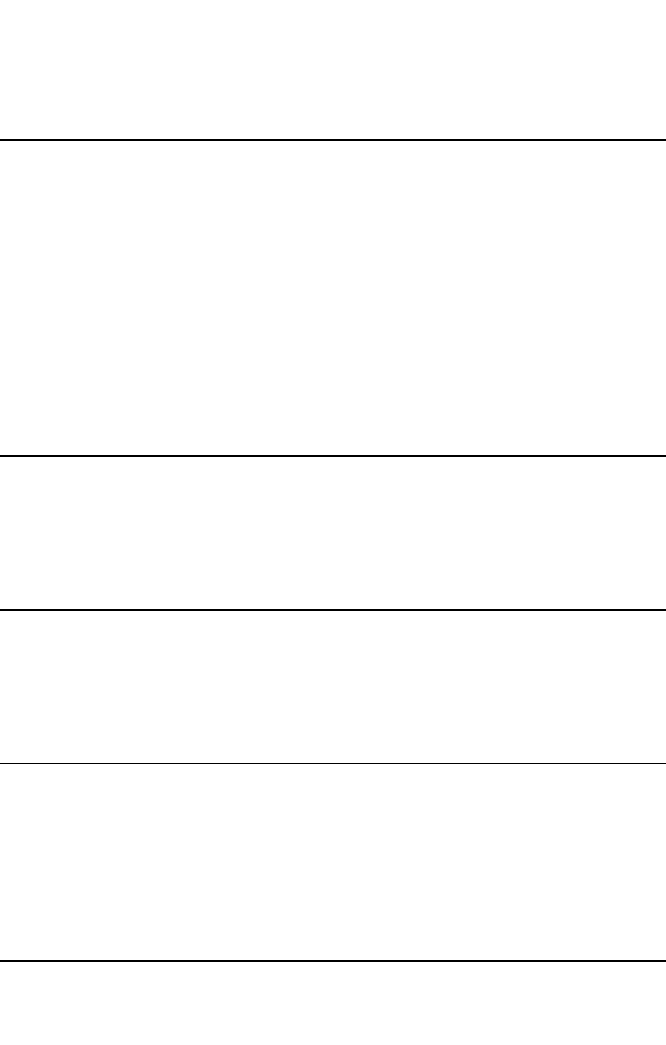
v
Table of Contents
Chapter 1: Introduction 1-1
RG230 Hardware Description 1-2
Scan Button 1-3
WiMAX Antennas 1-3
Wi-Fi Option 1-3
Power Status Indicator LED 1-3
Wi-Fi Status Indicator LED 1-4
WiMAX Signal Indicator LEDs 1-4
10BASE-T/100BASE-TX LAN Ports 1-5
VoIP Phone Ports 1-5
Power Adapter Socket 1-5
Reset Button 1-5
Chapter 2: Installing the RG230 2-1
Package Checklist 2-1
Installation Overview 2-1
Select a Location 2-1
Cable Connections 2-2
Chapter 3: Initial Configuration 3-1
Accessing the Web Management Interface 3-1
Home Page 3-2
Using the Setup Wizard 3-3
The Advanced Setup Menu 3-5
Chapter 4: System Settings 4-1
System Status 4-2
Administrator Settings 4-4
Firmware Update 4-4
Configuration Tools 4-5
System Time 4-5
Reset 4-7
Chapter 5: Gateway Configuration 5-1
LAN 5-2
LAN Settings 5-2

vi
Table of Contents
DHCP Client List 5-3
NAT 5-3
Virtual Server 5-3
Port Mapping 5-5
DMZ 5-6
Firewall 5-6
Firewall Options 5-7
Client Filtering 5-8
MAC Control 5-9
Route 5-10
UPnP 5-11
Chapter 6: WiMAX Settings 6-1
User Account Settings 6-1
Subscriber Station Information 6-2
Antenna Setting 6-3
Chapter 7: VoIP Settings 7-1
SIP Account 7-2
Dial Plan 7-3
Call Feature 7-5
Appendix A: Troubleshooting A-1
Diagnosing LED Indicators A-1
Cannot Connect to the Internet A-1
Cannot Access Web Management A-1
Forgot or Lost the Password A-2
Resetting the Unit A-2
Appendix B: Specifications B-1
Physical Specifications B-1
WiMAX Specifications B-2
VoIP Specifications B-3
Compliances B-3
Appendix C: Cables and Pinouts C-1
Twisted-Pair Cable Assignments C-1
10/100BASE-TX Pin Assignments C-1
Straight-Through Wiring C-2
Crossover Wiring C-2

viii
Table of Contents

ix
Tables
Table 1-1 RG230 Models 1-1
Table 1-2 Power Status LED 1-3
Table 1-3 Wi-Fi Status LED 1-4
Table 1-4 WiMAX Signal Status LEDs 1-4
Table 1-5 LAN Port Status LEDs 1-5
Table 4-1 System Settings 4-1
Table 5-1 Gateway Configuration 5-1
Table 6-1 WiMAX Settings 6-1
Table A-1 Troubleshooting Chart A-1
Table C-1. 10/100BASE-TX MDI and MDI-X Port Pinouts C-2
Table C-2. RJ-11 Port Pinout C-3

x
Figures
Figure 1-1 Front of the RG230 1-2
Figure 1-2 RG230 LED Indicators 1-3
Figure 1-3 Back of the RG230 1-4
Figure 1-4 Base of the RG230 1-6
Figure 2-1 RG230 Connections 2-2
Figure 3-1 Login Page 3-1
Figure 3-2 Home Page 3-2
Figure 3-3 WiMAX Login 3-3
Figure 3-4 Apply Settings 3-4
Figure 3-5 Setup Wizard Finished 3-4
Figure 3-6 Advanced Setup 3-5
Figure 4-1 System Status – Internet 4-2
Figure 4-2 System Status – Gateway 4-2
Figure 4-3 System Status – VoIP 4-3
Figure 4-4 System Status – Information 4-3
Figure 4-5 Setting a Password 4-4
Figure 4-6 Firmware Update 4-4
Figure 4-7 Configuration Tools 4-5
Figure 4-8 Restore Factory Default Configuration 4-5
Figure 4-9 System Time 4-6
Figure 4-10 Reset Unit 4-7
Figure 5-1 LAN Settings 5-2
Figure 5-2 DHCP Client List 5-3
Figure 5-3 Virtual Server 5-4
Figure 5-4 Port Mapping 5-5
Figure 5-5 DMZ Settings 5-6
Figure 5-6 Firewall Setting 5-6
Figure 5-7 Firewall Options 5-7
Figure 5-8 Client Filtering Settings 5-8
Figure 5-9 MAC Control 5-9
Figure 5-10 Routing Table 5-10
Figure 5-11 UPnP Setting 5-11
Figure 6-1 WiMAX Account Settings 6-1
Figure 6-2 Subscriber Station Information 6-2
Figure 6-3 WiMAX Antenna Setting 6-3
Figure 7-1 SIP Account Settings 7-2
Figure 7-2 Dial Plan Settings 7-3
Figure 7-3 Call Features 7-6
Figure C-1 RJ-45 Connector C-1
Figure C-2 Straight-Through Wiring C-2
Figure C-3 Crossover Wiring C-2
Figure C-4 RJ-11 Port Pinout C-3

1-1
Chapter 1: Introduction
The RG230 WiMAX 802.16e Self-Install Residential Gateway is a WiMAX subscriber
station designed to provide Internet access for a home or small office. The unit
provides a gateway function between a WiMAX service provider and a local
Ethernet LAN. The device enables a service provider to deliver last mile broadband
wireless access as an alternative to wired DSL or cable modems.
The RG230 is a plug-and-play device. There are two available models for each of
the 2.3, 2.5, and 3.5 GHz WiMAX frequency bands. Which model you use will
depend on the frequency band of your service provider’s WiMAX service.
The RG230 includes four RJ-45 Ethernet switch ports for LAN connections and two
optional RJ-11 Voice over IP (VoIP) phone ports. An 802.11b/g Wi-Fi module is
available for the 3.5 GHz models that provides a local Wi-Fi access point service.
For the 2.5 GHz SKUs, the RG230 covers the ATC frequency band from
2483.5 MHz up to 2690 MHz.
The following table lists the available RG230 models.
The RG230 offers a user-friendly web-based management interface for the
configuration of all the unit’s features. Any PC directly attached to the unit can
access the management interface using a web browser, such as Internet Explorer
(version 6.0 or above) or Firefox (version 1.5 or above).
Table 1-1 RG230 Models
Frequency Band Model Number Description
2.3 GHz RG230-2.3-1D Unit with 1 data port.
RG230-2.3-1D2V Unit with 1 data port and 2 VoIP ports.
RG230-2.3-4D Unit with 4 data ports.
RG230-2.3-4D2V Unit with 4 data ports and 2 VoIP ports.
2.5 GHz RG230-2.5-1D Unit with 1 data port.
RG230-2.5-1D2V Unit with 1 data port and 2 VoIP ports.
RG230-2.5-4D Unit with 4 data ports.
RG230-2.5-4D2V Unit with 4 data ports and 2 VoIP ports.
3.5 GHz RG230-3.5-1D Unit with 1 data port.
RG230-3.5-1D2V Unit with 1 data port and 2 VoIP ports.
RG230-3.5-4D Unit with 4 data ports.
RG230-3.5-4D2V Unit with 4 data ports and 2 VoIP ports.
RG230-3.5-4D1W Unit with 4 data ports and Wi-Fi.
RG230-3.5-4D2V1W Unit with 4 data ports, 2 VoIP ports, and Wi-Fi.

Introduction
1-2
1
The initial configuration steps can be made through the web browser interface using
the Setup Wizard. It is recommended to make the initial changes by connecting a
PC directly to one of the RG230’s LAN ports.
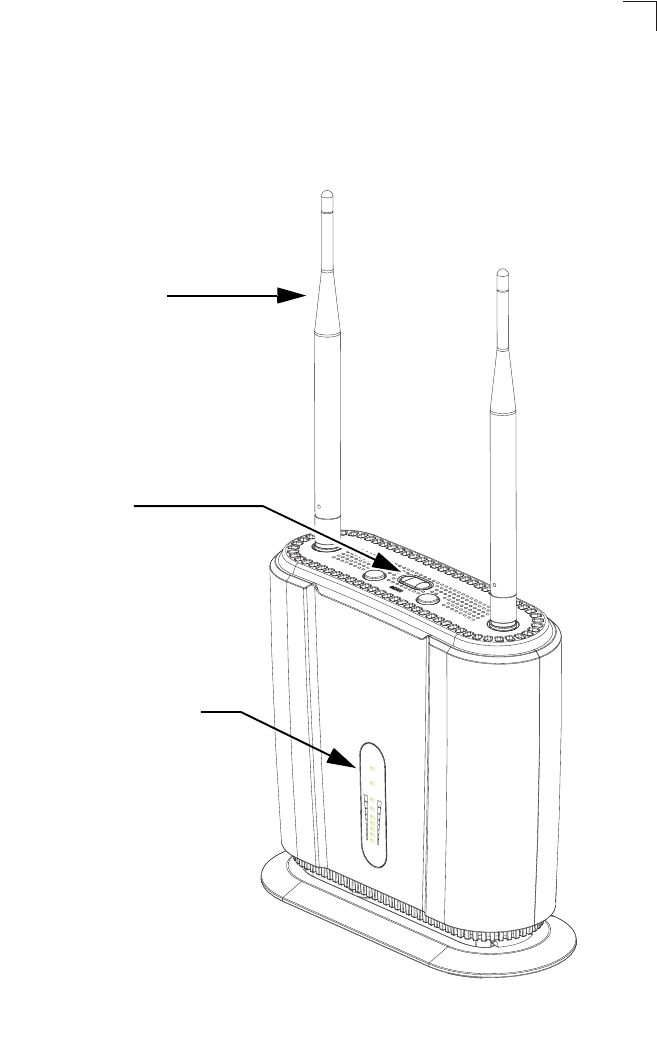
RG230 Hardware Description
1-3
1
RG230 Hardware Description
The front of the RG230 provides an array of system status indicators. The back
includes four LAN ports for 10/100 Mbps Ethernet connections, two RJ-11 VoIP
phone ports (on some models), and a DC power jack.
Figure 1-1 Front of the RG230
Power
WiFi
WiMAX
LED Status Indicators
Scan Button
WiMAX Antennas
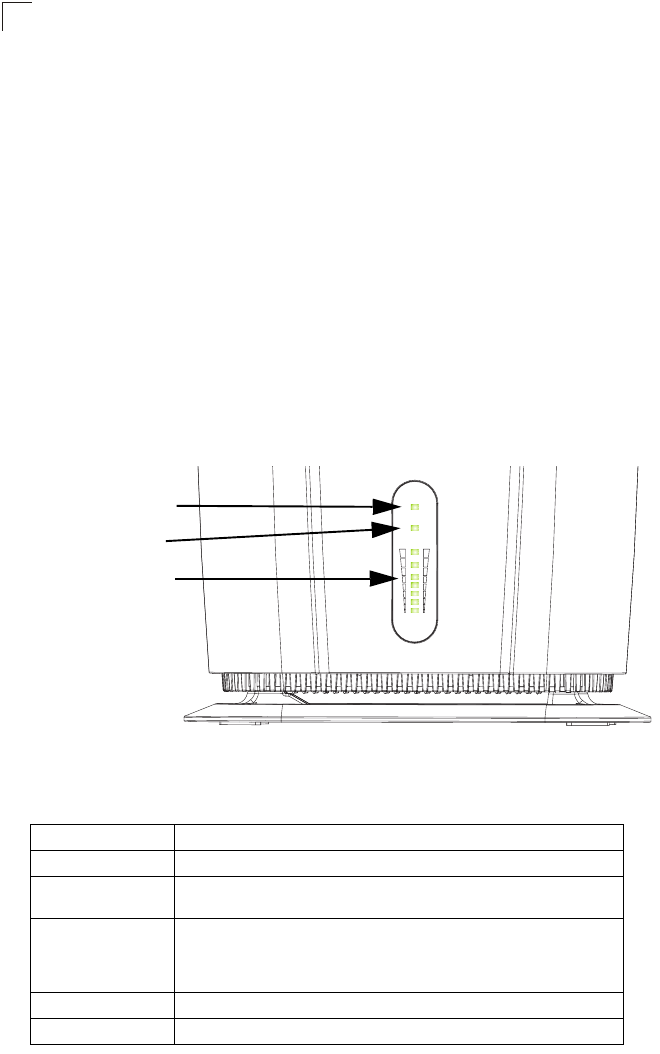
Introduction
1-4
1
Scan Button
This button is used to scan WiMAX operating channels. When you press the button,
the unit will perform a scan to find the best of the known frequency channels.
WiMAX Antennas
Two antennas are included with the RG230 for WiMAX communications. The
omnidirectional antennas transmit and receive signals in all directions equally.
Wi-Fi Option
The RG230 3.5 GHz model includes the 802.11b/g Wi-Fi option. This unit includes
internal antennas for local wireless connections to PCs.
Power Status Indicator LED
The RG230 includes a Power LED indicator that simplifies installation and WiMAX
network troubleshooting. The LED, which is located on the front panel, is described
in the following table.
Figure 1-2 RG230 LED Indicators
Table 1-2 Power Status LED
Status Description
On Green The unit has completed entry to a WiMAX network.
Blinking Green When blinking with three of the WiMAX signal LEDs turned on, indicates
authentication has failed.
On Orange Indicates one of the following conditions:
• After power on, indicates the unit is running its self test.
• Indicates the network entry process has restarted.
On Red A system failure has occured.
Off No power is being supplied to the unit.
Power
WiFi
WiMAX
Power Status LED
Wi-Fi Status LED
WiMAX Signal LEDs
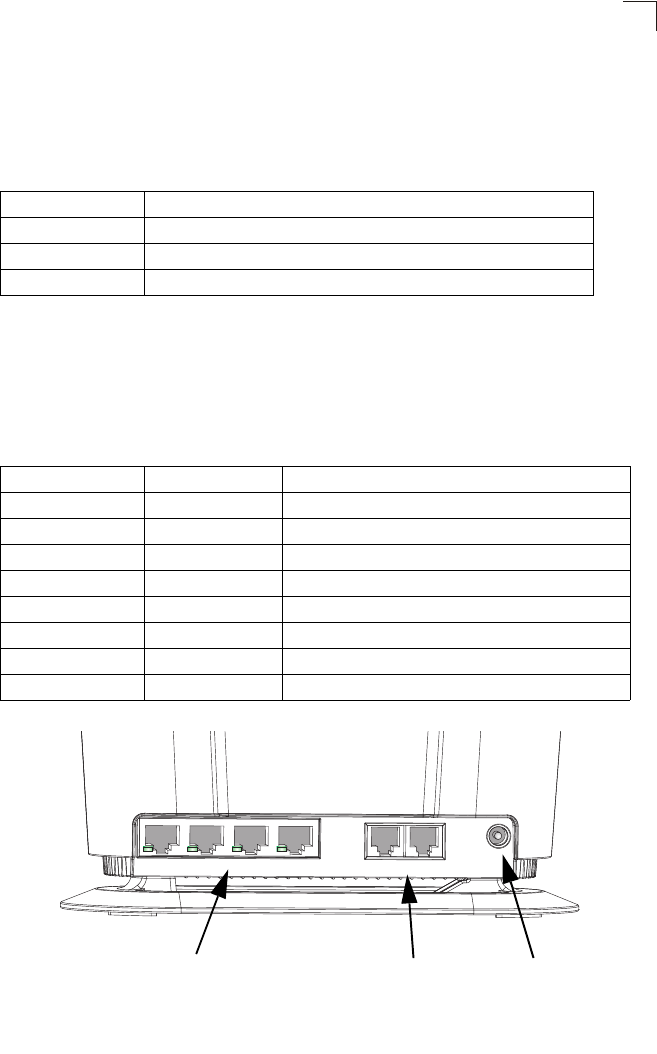
RG230 Hardware Description
1-5
1
Wi-Fi Status Indicator LED
The 3.5 GHz RG230 model, which supports Wi-Fi operation, includes a Wi-Fi LED
indicator that displays the Wi-FI network status. The LED, which is located on the
front panel, is described in the following table.
WiMAX Signal Indicator LEDs
The RG230 includes seven WiMAX signal strength LED indicators that display the
current WiMAX receive signal status. The LEDs, which are located on the front
panel, are described in the following table.
Figure 1-3 Back of the RG230
Table 1-3 Wi-Fi Status LED
Status Description
On Green The Wi-Fi radio is enabled and operating normally.
Flashing Green Indicates data traffic in the Wi-Fi network.
Off There is no Wi-Fi connection or the radio is disabled.
Table 1-4 WiMAX Signal Status LEDs
LED Status Description
1 On Green Indicates the receive signal is 5 dB or more.
2 On Green Indicates the receive signal is 8 dB or more.
3 On Green Indicates the receive signal is 12 dB or more.
4 On Green Indicates the receive signal is 15 dB or more.
5 On Green Indicates the receive signal is 18 dB or more.
6 On Green Indicates the receive signal is 20 dB or more.
7 On Green Indicates the receive signal is 25 dB or more.
All 7 LEDs Off No power is being supplied to the unit.
PHONE 1 PHONE 2LAN 1 LAN 2 LAN 3 LAN 4
DC IN
RJ-45 LAN Ports
(include Link/Activity LEDs)
VoIP Phone Ports Power Socket

Introduction
1-6
1
10BASE-T/100BASE-TX LAN Ports
The RG230 provides four 10BASE-T/100BASE-TX RJ-45 ports. These LAN ports
are standard RJ-45 Ethernet network ports that connect directly to PCs. They can
also be connected to an Ethernet switch or hub to support more users.
All ports support automatic MDI/MDI-X operation, so you can use straight-through
cables for all network connections to PCs or servers, or to other switches or hubs.
Each of these ports support auto-negotiation, so the optimum transmission mode
(half or full duplex), and data rate (10 or 100 Mbps) is selected automatically.
Each RJ-45 port includes a built-in LED indicator. This LED indicator is described in
the following table.
VoIP Phone Ports
Some RG230 models optionally provide two RJ-11 telephone ports that connect
directly to a standard (analog) telephone set. This allows a regular telephone to be
used for making VoIP calls over the Internet.
Power Adapter Socket
The power socket is located on the rear panel of the RG230. The power socket is for
the AC power adapter connection.
The unit is powered on when connected to its AC power adapter, and the power
adapter is connected to an AC power source between 100-240 volts at 50-60Hz.
Reset Button
This button is used to reset the RG230 or restore the factory default configuration. If
you press the button for less than 1 second, the unit will perform a hardware reset. If
you press and hold down the button for 5 seconds or more, any configuration
changes you may have made are removed, and the factory default configuration is
restored to the unit.
Table 1-5 LAN Port Status LEDs
LED Status Description
Link/Activity On Green Ethernet port has a valid link with an attached device.
Flashing Green The port is transmitting or receiving data.
Off Ethernet port has no link with another device.
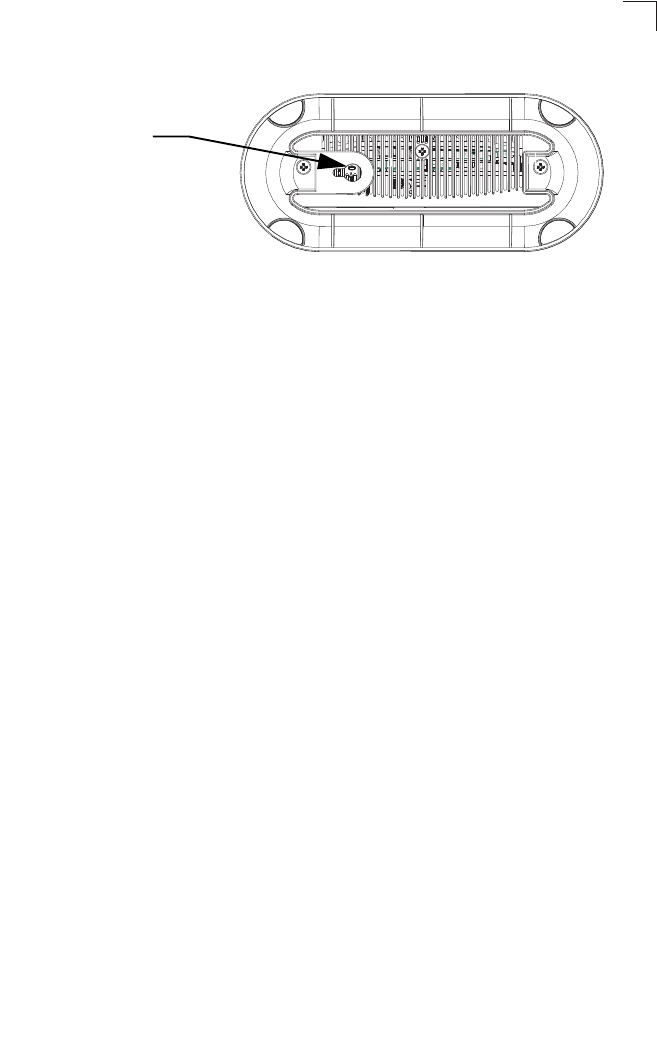
RG230 Hardware Description
1-7
1
Figure 1-4 Base of the RG230
Reset Button

Introduction
1-8
1

2-1
Chapter 2: Installing the RG230
This section describes how to install and connect the RG230 WiMAX 802.16e
Self-Install Residential Gateway.
Package Checklist
The RG230 package includes:
• RG230 unit (RG230-2.3, RG230-2.5, or RG230-3.5)
• RJ-45 Category 5 network cable
• AC power adapter
• Quick Installation Guide
• User Guide CD
Installation Overview
Before installing the RG230, verify that you have all the items listed in the package
checklist above. If any of the items are missing or damaged, contact your local
dealer. Also, be sure you have all the necessary tools and cabling before installing
the RG230.
Select a Location
The RG230 can be installed indoors on any horizontal surface, such as a desktop or
shelf.
When selecting a suitable location for the device, consider these guidelines:
• Select a cool, dry place, which is out of direct sunlight.
• The device should have adequate space (approximately two inches) on all sides
for proper air flow.
• The device must be near an AC power outlet that provides 100 to 240 V, 50 to
60 Hz.
• The device should be accessible for network cabling and allow the status LED
indicators to be clearly visible.
Note: If the RG230 displays a weak WiMAX receive signal, try moving it to another
location.
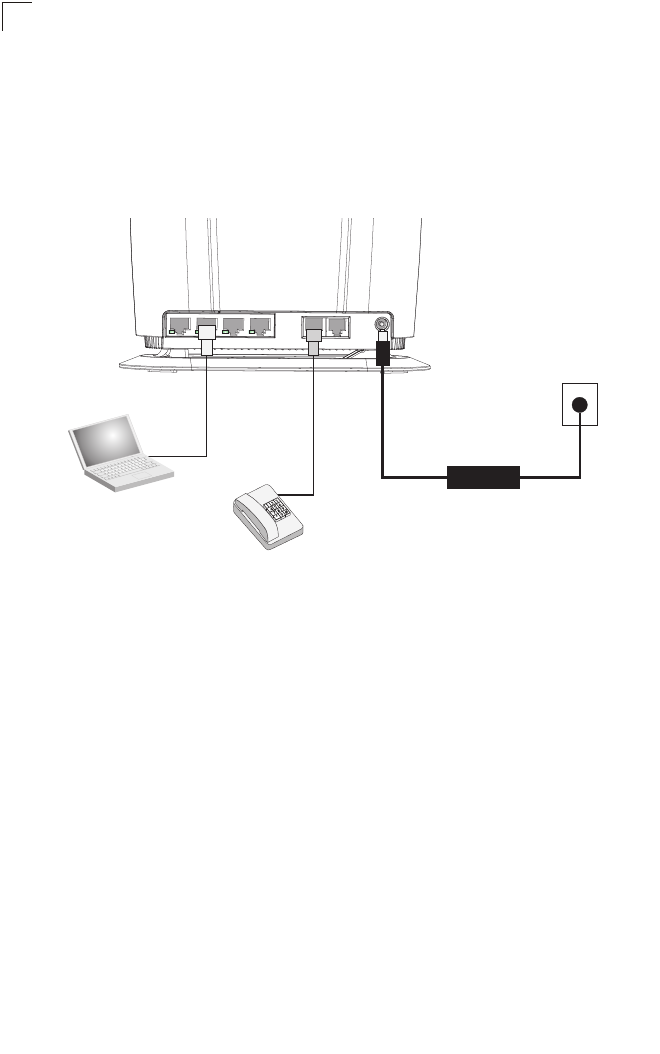
2-2
Installing the RG230
2
Cable Connections
The RG230 is a plug-and-play device, so once it has been connected to your PC
and powered up, it is fully operable.
Functioning as a gateway, the unit routes traffic between a WiMAX service
provider’s base station and PCs or notebooks in the local network.
Figure 2-1 RG230 Connections
To connect the RG230, follow these steps:
1. Power on the RG230 by by first connecting the AC power adapter to the unit’s
power socket, and then connecting the adapter to an AC power source.
Caution: Use ONLY the power adapter supplied with the RG230. Otherwise, the
product may be damaged.
2. Observe the Indicator LEDs. When you power on the RG230, verify that the
Power LED turns on and that the other LED indicators start functioning as
described under “RG230 Hardware Description” on page 1-2.
3. Connect Category 5 or better Ethernet cables from the RG230’s LAN ports to
the network ports of your PCs. Alternatively, you can connect the LAN ports to
an Ethernet switch or other devices. Make sure the length of each cable does
not exceed 100 meters (328 ft).
If your PCs are powered on, the RJ-45 LAN port LEDs on the RG230 should
turn on to indicate valid links.
Notebook Computer AC Power Adapter
AC Power Outlet
PHONE 1 PHONE 2LAN 1 LAN 2 LAN 3 LAN 4
DC IN
2A
10-19V
Regular Phone

2-3
Cable Connections
2
4. (Optional) Connect one or two standard (analog) telephone sets to the RG230’s
VoIP ports using standard telephone cable with RJ-11 plugs.
The RG230 enables VoIP calls to be made through the unit using a standard
(analog) telephone set connected to a VoIP port, or from PCs or other network
devices connected to the LAN ports. Standard Session Initiation Protocol (SIP)
technology is used to make VoIP calls. You must access the web interface and
configure settings for your SIP service provider before being able to make VoIP
calls.
5. Use your PC’s web browser to access the unit’s management interface and run
the Setup Wizard to make any configuration changes. For more information,
see Chapter 3, “Initial Configuration.”

2-4
Installing the RG230
2
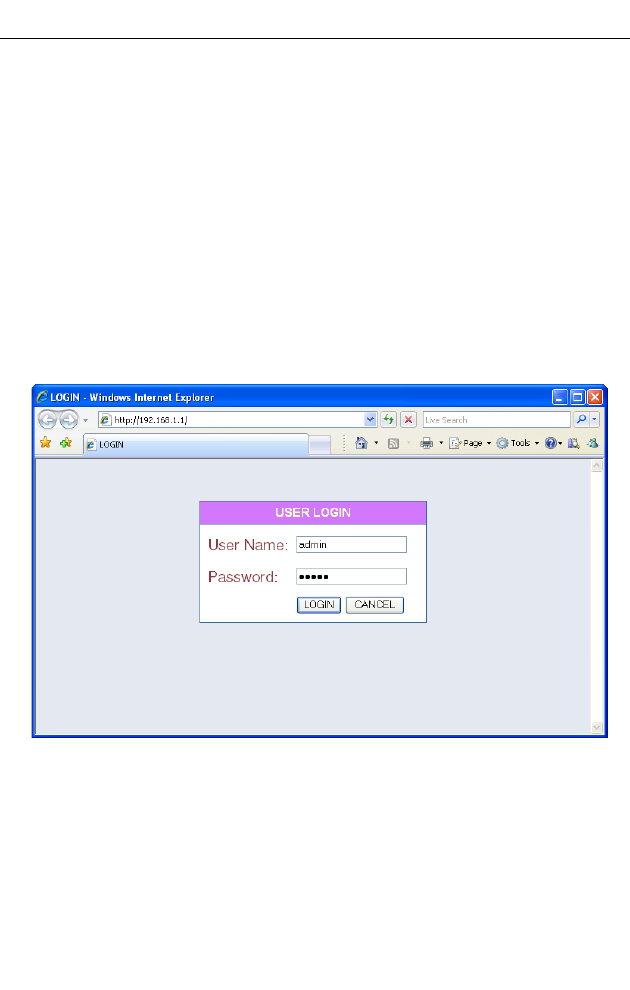
3-1
Chapter 3: Initial Configuration
The RG230 can be configured through its web management interface. The web
interface provides a simple Setup Wizard or Advanced Setup options.
Accessing the Web Management Interface
The RG230 has a default IP address of 192.168.1.1 and a subnet mask of
255.255.255.0. If your PC is set to have an IP address assigned by DHCP (Dynamic
Host Configuration Protocol), you can connect immediately to the web management
interface. Otherwise, you must first check if your PC’s IP address is set on the same
subnet as the RG230 (that is, the PC’s IP address starts 192.168.1.x).
In the web browser’s address bar, type the default IP address: http://192.168.1.1.
The web browser displays the RG230’s login page.
Figure 3-1 Login Page
Logging In – Type the default User Name “admin” and Password “admin,” then click
Login. The home page displays.
Note: It is recommended that you configure a user password as the first step under
“Administrator Settings” on page 4-4 to control management access to the unit.
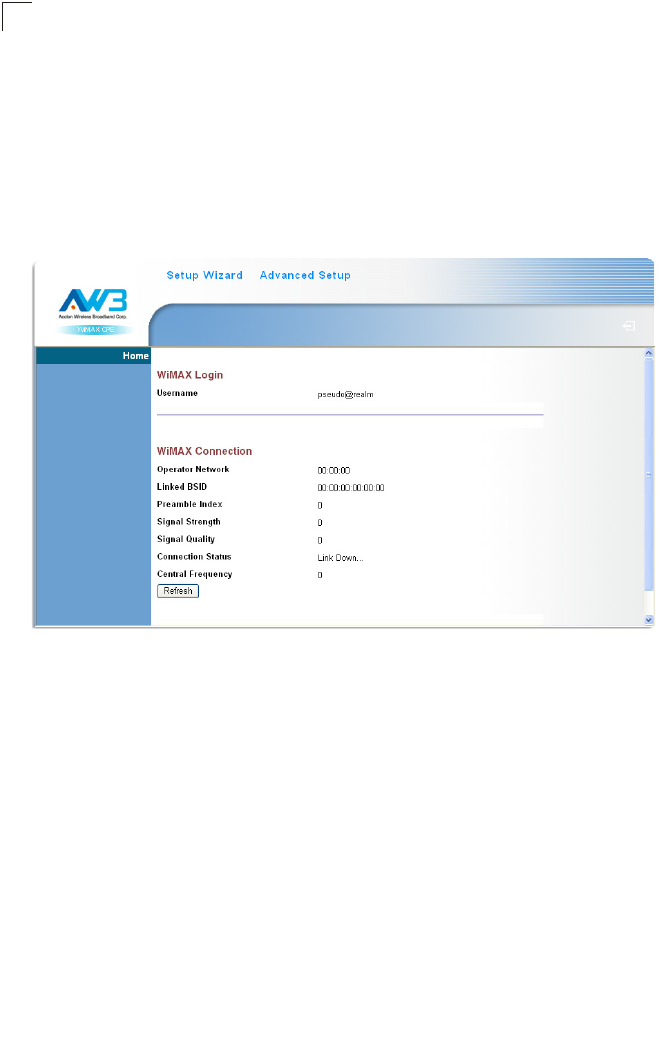
Initial Configuration
3-2
3
Home Page
The home page displays the current status of the WiMAX connection.
To configure basic settings for the current operating mode, click Setup Wizard. For
more information, see “Initial Configuration” on page 3-1.
Alternatively, to configure more detailed settings, click Advanced Setup. For more
information, see “The Advanced Setup Menu” on page 3-5.
Figure 3-2 Home Page
The following parameters are displayed on the home page:
• Username – Describes the WiMAX network login name.
• Operator Network – The identity of the operator network.
• Linked BSID – The identifier of the connected base station.
• Preamble Index – A number that identifies the sector on the connected base
station.
• Signal Strength – The current signal strength value of the received WiMAX radio
signal.
• Signal Quality – An indication of the carrier-to-interference-plus-noise-ratio
(CINR), which measures the strength of the receive signal compared to other
interference and noise.
• Connection Status – The current status of the WiMAX connection.
• Central Frequency – The center frequency of the WiMAX signal.
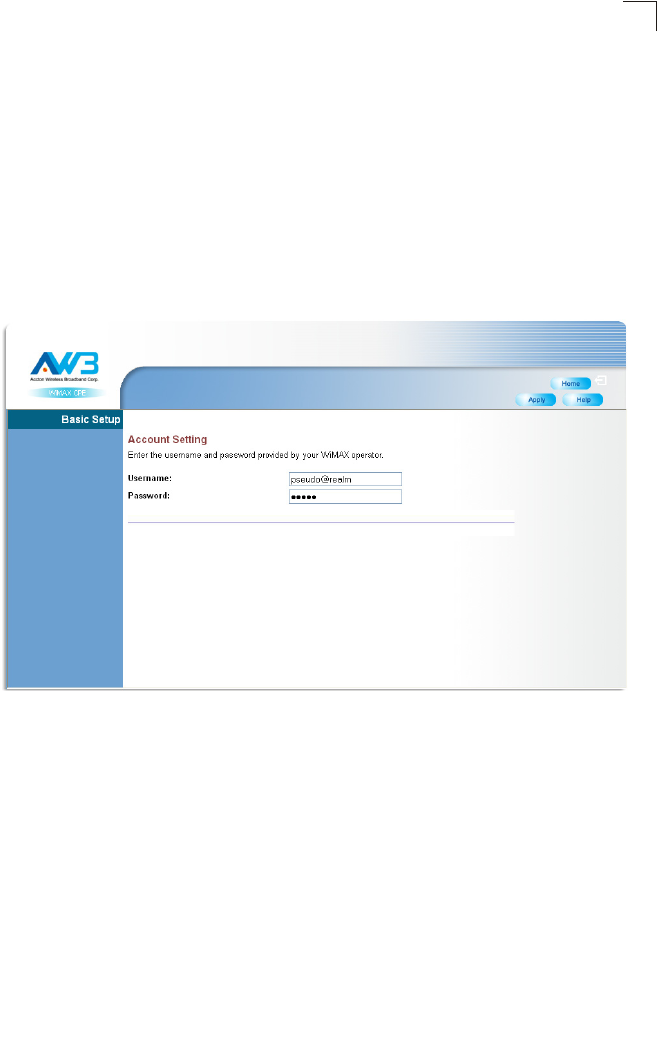
Using the Setup Wizard
3-3
3
Using the Setup Wizard
The Setup Wizard takes you through the basic configuration steps for the RG230.
Launching the Setup Wizard– To perform basic configuration, click Setup Wizard
on the home page.
When configuring the unit through the Setup Wizard you will need to proceed
through the following steps:
1. WiMAX Login – Configures user authentication settings for connection to the
WiMAX network.
Figure 3-3 WiMAX Login
User Name – The user name required for authentication as provided by the
WiMAX operator. (Default: pseudo@realm)
Password – The user password required for authentication as provided by the
WiMAX operator. (Default: hello)
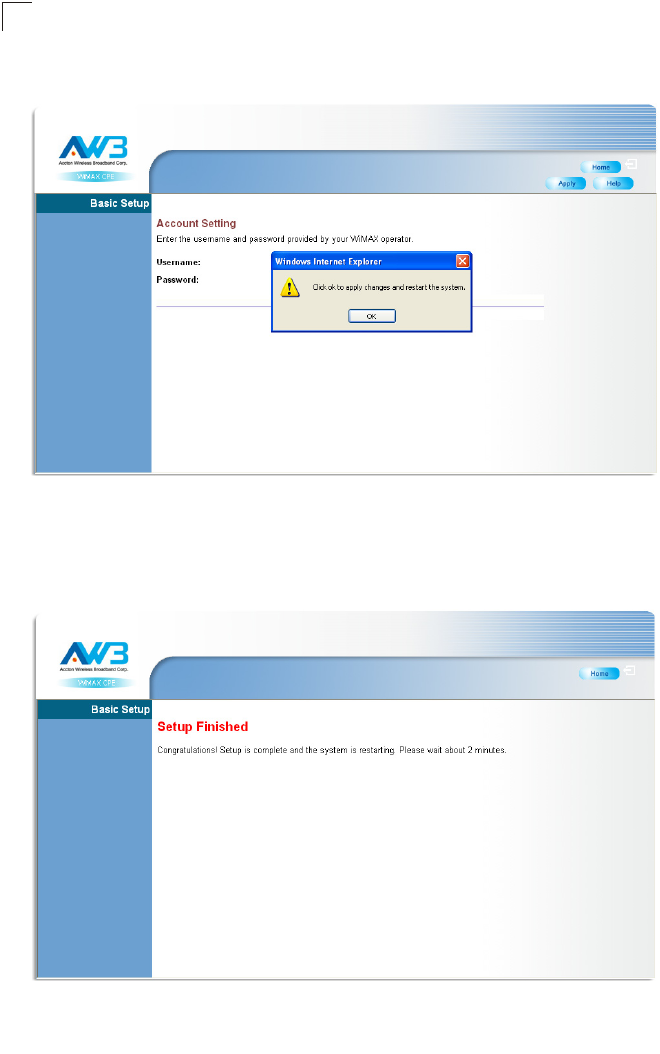
Initial Configuration
3-4
3
2. Apply Settings – Click “Apply” to confirm the basic settings.
Figure 3-4 Apply Settings
3. Basic Setup Finished – When the Setup Wizard steps are completed the unit
reboots and attempts to connect to the specified WiMAX network. Click on the
Home button to return to the Home page.
Figure 3-5 Setup Wizard Finished
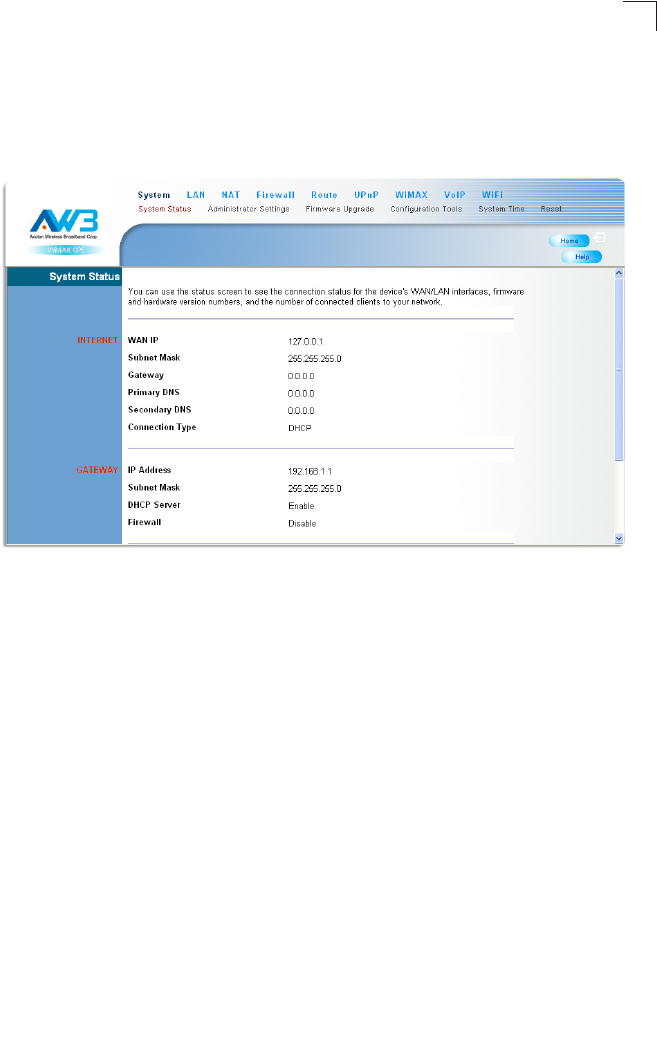
The Advanced Setup Menu
3-5
3
The Advanced Setup Menu
The Advanced Setup menu provides access to all the configuration settings
available for the RG230.
Figure 3-6 Advanced Setup
Each primary menu item is sumarized below with links to the relevant section in this
guide where configuration parameters are described in detail:
• System – Configures general device settings. see page 4-1
• LAN – Configures LAN settings. see page 5-2
• NAT – Configures Network Address Translation settings. see page 5-3
• Firewall – Configures firewall settings. see page 5-6
• Route – Configures static routing settings. see page 5-10
• UPnP – Enables UPnP. see page 5-11
• WiMAX – Views the wireless connection status. see page 6-1
• VoIP – Configures VoIP SIP settings. see page 7-1
• WiFi – Configures 802.11 access point settings. see page 8-1

Initial Configuration
3-6
3

4-1
Chapter 4: System Settings
The RG230’s System menu allows you to perform general management functions
for the unit, including setting the system time, configuring an access password, and
upgrading the system software.
The System pages include the following options.
Table 4-1 System Settings
Menu Description Page
System Status Displays WAN and LAN interface information and other system
details
4-2
Administrator Settings Configures user password for management
access
4-4
Firmware Upgrade Updates the current firmware 4-4
Configuration Tools Restores the factory default settings, or save the unit’s current
settings
4-5
System Time Configures the system time settings for updates from a time server 4-5
Reset Resets the device 4-7
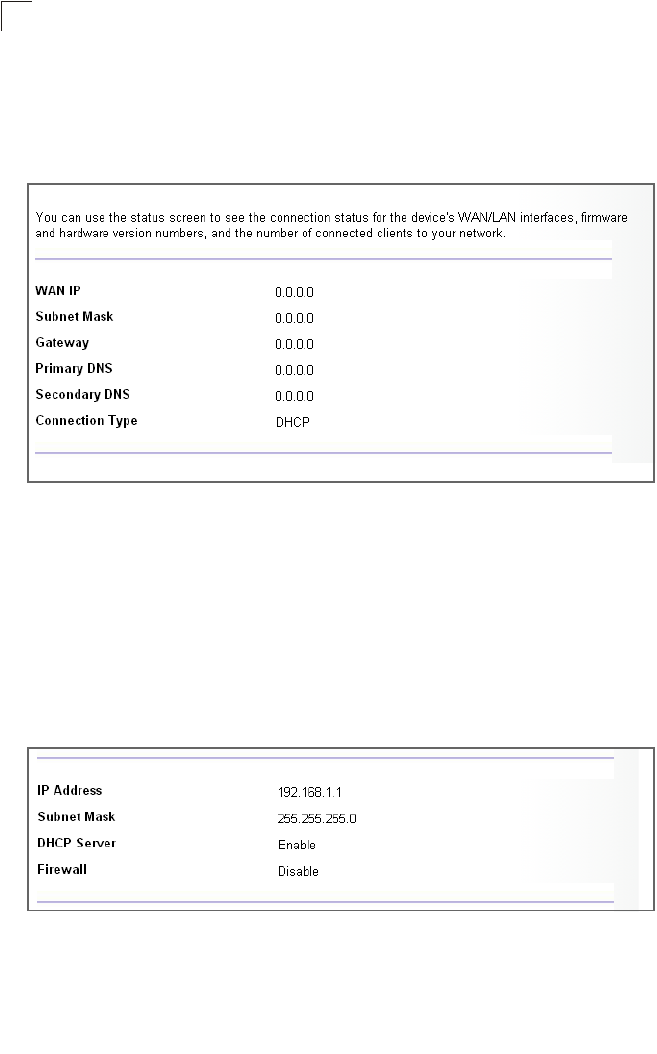
System Settings
4-2
4
System Status
The system status page displays connectivity status information for the unit’s
WiMAX (WAN) and LAN interfaces, firmware and hardware version numbers, and
the number of clients connected to your network.
Figure 4-1 System Status – Internet
INTERNET – Displays WAN (WiMAX) connection status:
•WAN IP – Displays the IP address assigned by the service provider.
•Subnet Mask – Displays the WAN subnet mask assigned by the service provider.
•Gateway – Displays the WAN gateway address assigned by the service provider.
•Primary DNS – Displays the WAN primary DNS address.
•Secondary DNS – Displays the WAN secondary DNS address.
•Connection Type – Displays the connection type for the WAN. Either FIXED for a
static IP setting, or DHCPC for dynamic IP assignment.
Figure 4-2 System Status – Gateway
GATEWAY – Display system IP settings, as well as DHCP, NAT and firewall status:
•IP Address – Displays the unit’s IP address.
•Subnet Mask – Displays the subnet mask.
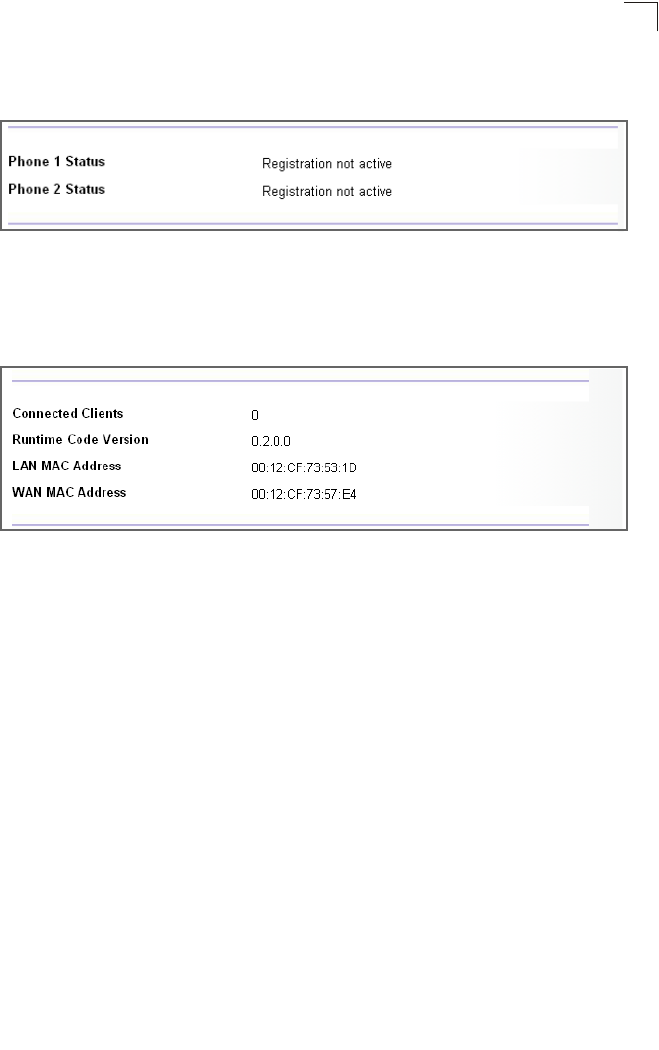
System Status
4-3
4
•DHCP Server – Displays the DHCP server status.
•Firewall – Displays the firewall status.
Figure 4-3 System Status – VoIP
VoIP STATUS – Displays the VoIP phone status:
•Phone 1 Status – Displays the SIP status of phone line 1.
•Phone 2 Status – Displays the SIP status of phone line 2.
Figure 4-4 System Status – Information
INFORMATION – Displays the number of connected clients, as well as the unit’s
LAN and WAN MAC addresses:
•Connected Clients – Displays the number of connected clients, if any.
•Runtime Code Version – Displays the runtime code version.
•LAN MAC Address – Displays the LAN MAC address.
•WAN MAC Address – Displays WAN MAC address.
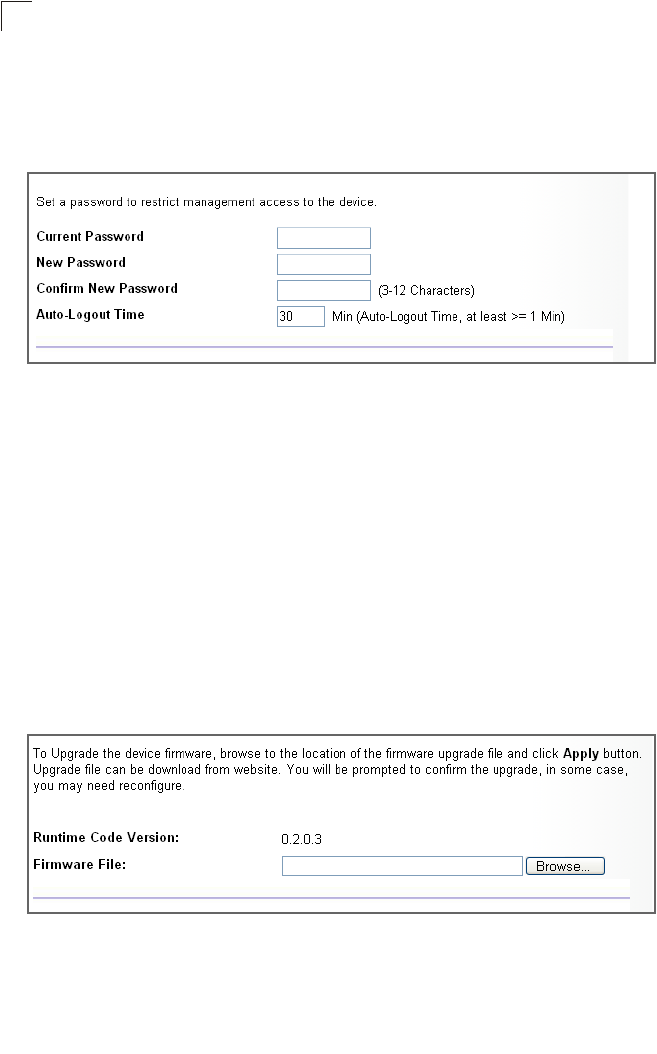
System Settings
4-4
4
Administrator Settings
The Administrator Settings page enables you to change the default password for
management access to the RG230.
Figure 4-5 Setting a Password
Current Password – You need to first enter your current administrator password to
be able to configure a new one. (Default: admin)
New Password – Enter a new administrator password. (Range: 3~12 characters)
Confirm New Password – Enter the new password again for verification.
(Range: 3~12 characters)
Auto-Logout Time – The time of inactivity after which the unit terminates a web
management session. (Default: 30 minutes; Range: 1~99 minutes)
Firmware Update
The Firmware Update page enables you to download new software to the unit.
Figure 4-6 Firmware Update
Firmware Update – Downloads an operation code file from the web management
station to the RG230 using HTTP. Use the Browse button to locate the code file
locally on the management station and click Apply to proceed.
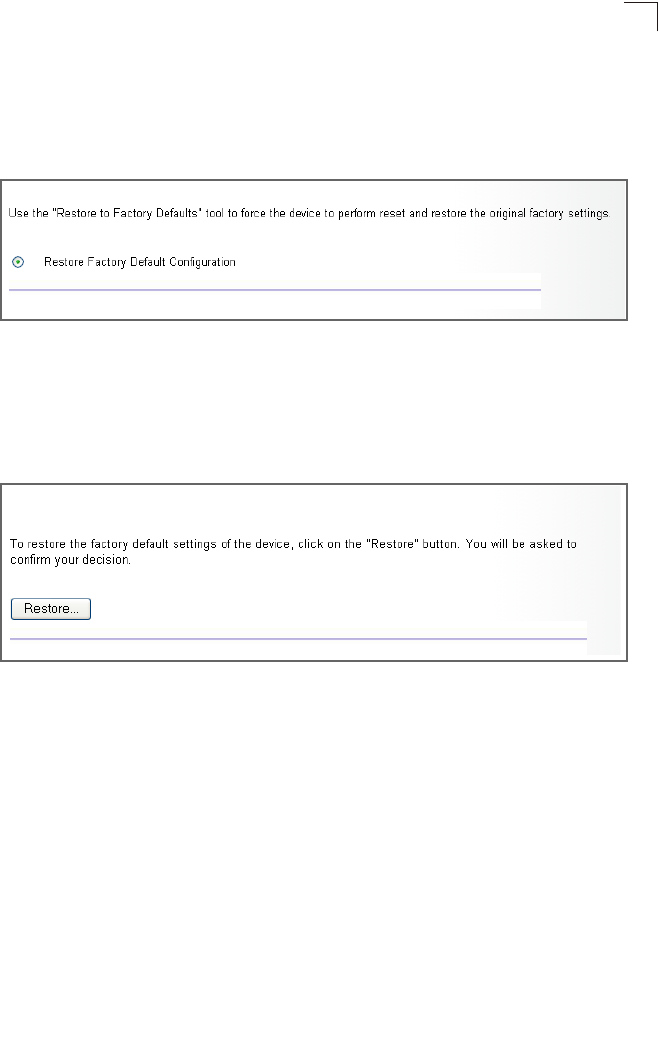
Configuration Tools
4-5
4
Configuration Tools
The Configurations Tools page allows you to restore factory default settings, or save
and restore the unit’s configuration settings to or from a file on the management
station.
Figure 4-7 Configuration Tools
Restore Factory Default Configuration – Resets the unit to its factory default
settings.
When you select “Restore Factory Default Configuration” and click Apply, a
confirmation page displays. Click the Restore button to continue.
Figure 4-8 Restore Factory Default Configuration
System Time
The RG230 uses the Simple Network Time Protocol (SNTP) to set its internal clock
based on periodic updates from a time server. Maintaining an accurate time on the
device enables the system log to record meaningful dates and times for event
entries.
SNTP uses Coordinated Universal Time (or UTC, formerly Greenwich Mean Time,
or GMT) based on the time at the Earth’s prime meridian, zero degrees longitude. To
display a time corresponding to your local time, you must select your time zone.
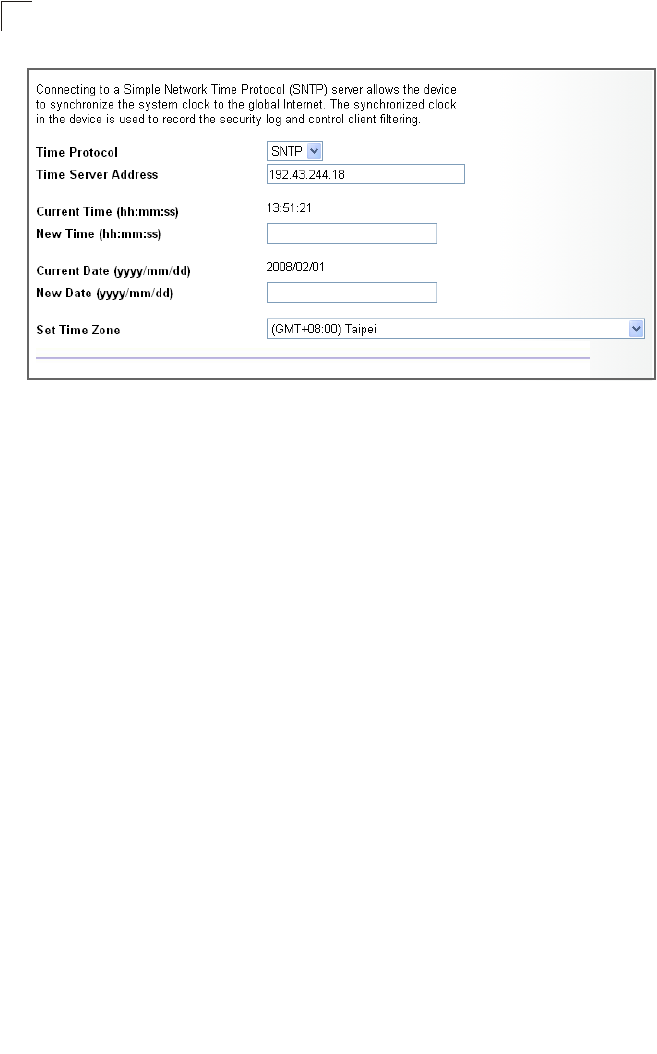
System Settings
4-6
4
Figure 4-9 System Time
Time Protocol – Select SNTP to enable the unit to set its internal clock based on
periodic updates from a time server. The unit acts as an SNTP client, periodically
sending time synchronization requests to a specified time server. Alternatively, you
can select “None” and set the time and date manually. (Default: SNTP)
Time Server Address – The IP address of a time server that the unit attempts to
poll for a time update. (Default: 192.43.244.18)
Current Time (hh:mm:ss) – Displays the current time of the system clock.
New TIme (hh:mm:ss) – Sets the system clock to the time specified.
Current Date (yyyy:mm:dd) – Displays the current date of the system clock.
New Date (yyyy:mm:dd) – Sets the system clock to the date specified.
Set Time Zone – SNTP uses Coordinated Universal Time (or UTC, formerly
Greenwich Mean Time, or GMT) based on the time at the Earth’s prime meridian,
zero degrees longitude. To display a time corresponding to your local time, you must
select your time zone from the pull-down list. (Default: (GMT+08:00) Taipei)
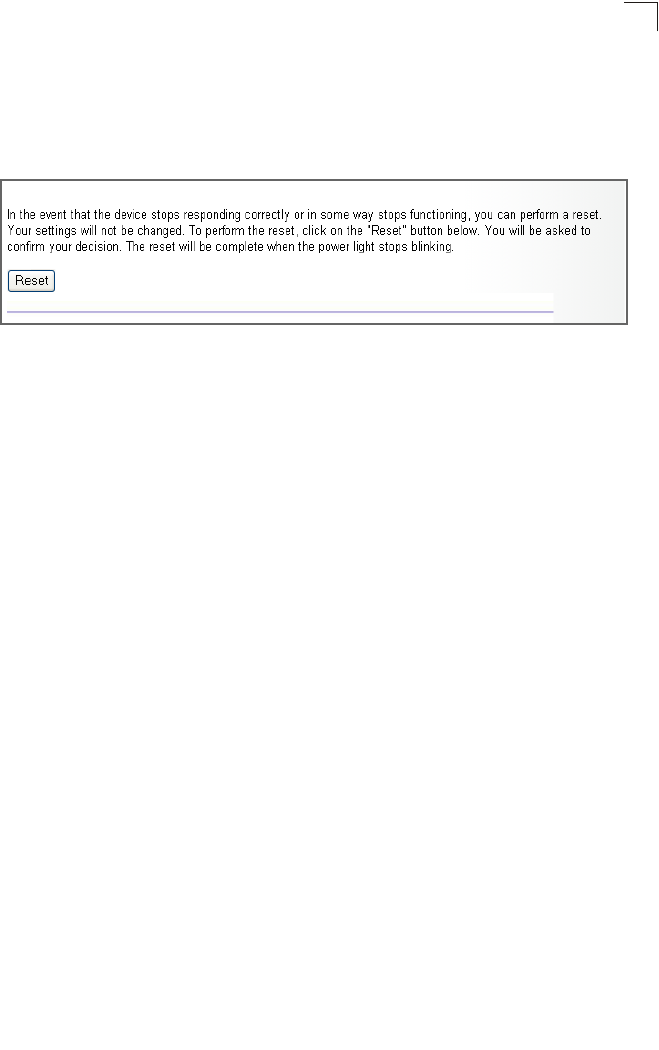
Reset
4-7
4
Reset
The Reset page allows you to restart the device’s software. If the unit stops
responding correctly or in some way stops functioning, performing a reset can clear
the condition.
Figure 4-10 Reset Unit
Reset – Resets the unit. All current settings are retained.

System Settings
4-8
4
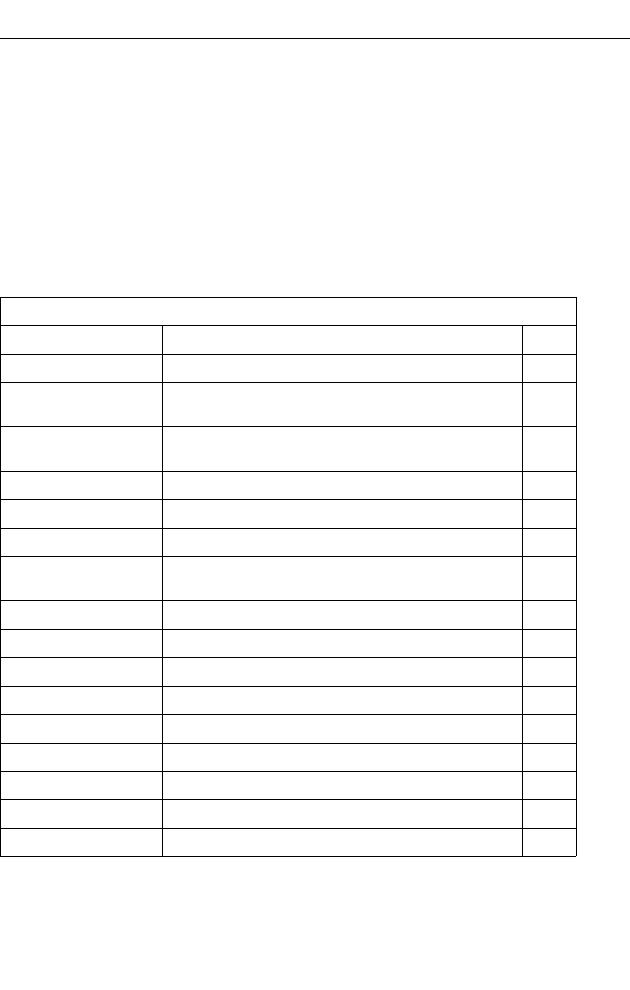
5-1
Chapter 5: Gateway Configuration
The information in this chapter covers the configuration options for the RG230’s
Internet gateway functions.
The RG230 provides comprehensive firewall features and NAT isolation for Internet
traffic passing from the WiMAX service provider to the local network connected to
the LAN ports. The DHCP server feature can assign IP addresses for up to 32 local
network PCs and wireless clients.
The Advanced Setup menu includes the following items for Internet gateway
configuration.
Table 5-1 Gateway Configuration
Menu Description Page
LAN 5-2
LAN Settings Sets the unit’s IP address and configures the DHCP server
for the local network
5-2
DHCP Client List Displays connected DHCP clients that have been assigned
IP addresses by the DHCP server
5-3
NAT 5-3
Virtual Server Allows the unit to be configured as a virtual server 5-3
Port Mapping Enables IP port mapping for special applications 5-5
DMZ Allows clients to connect to the unit directly bypassing the
firewall
5-6
Firewall 5-6
Firewall Setting Controls access to and from the local network 5-6
Firewall Options Blocks scans of the network services from an outside hacker 5-6
Client Filtering Blocks Internet access based on IP addresses 5-8
MAC Control Blocks internet access based on MAC addresses 5-9
Route 5-10
Routing Table List Displays the routing table 5-10
UPnP 5-11
Settings Provides support for Universal Plug and Play devices 5-11
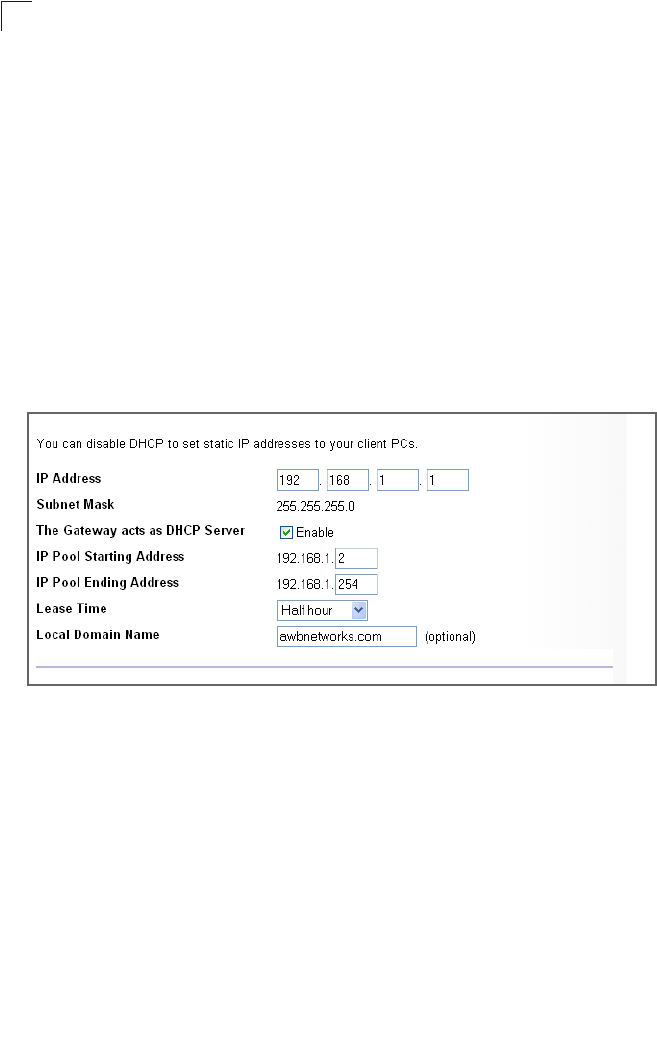
Gateway Configuration
5-2
5
LAN
The RG230 must have a valid IP address for management using a web browser and
to support other features. The unit has a default IP address of 192.168.1.1. You can
use this IP address or assign another address that is compatible with your existing
local network. The unit can also be enabled as a Dynamic Host Configuration
Protocol (DHCP) server to allocate IP addresses to local PCs.
LAN Settings
The RG230 includes a DHCP server that can assign temporary IP addresses to any
attached host requesting the service. Addresses are assigned to clients from a
common address pool configured on the unit. Configure an address pool by
specifying start and end IP addresses. Be sure not to include the unit's IP address in
the address pool range.
Figure 5-1 LAN Settings
IP Address – The IP address of the unit. Valid IP addresses consist of four decimal
numbers, 0 to 255, separated by periods.The default setting is 192.168.1.1.
Subnet Mask – Indicates the local subnet mask is fixed as 255.255.255.0.
The Gateway acts as DHCP Server – Check this box to enable the DHCP server.
IP Pool Starting/Ending Address – Specifies the start and end IP address of a
range that the DHCP server can allocate to DHCP clients. You can specify a single
address or an address range. Note that the address pool range is always in the
same subnet as the unit’s IP setting. (Default: 192.168.1.2 to 192.168.1.254)
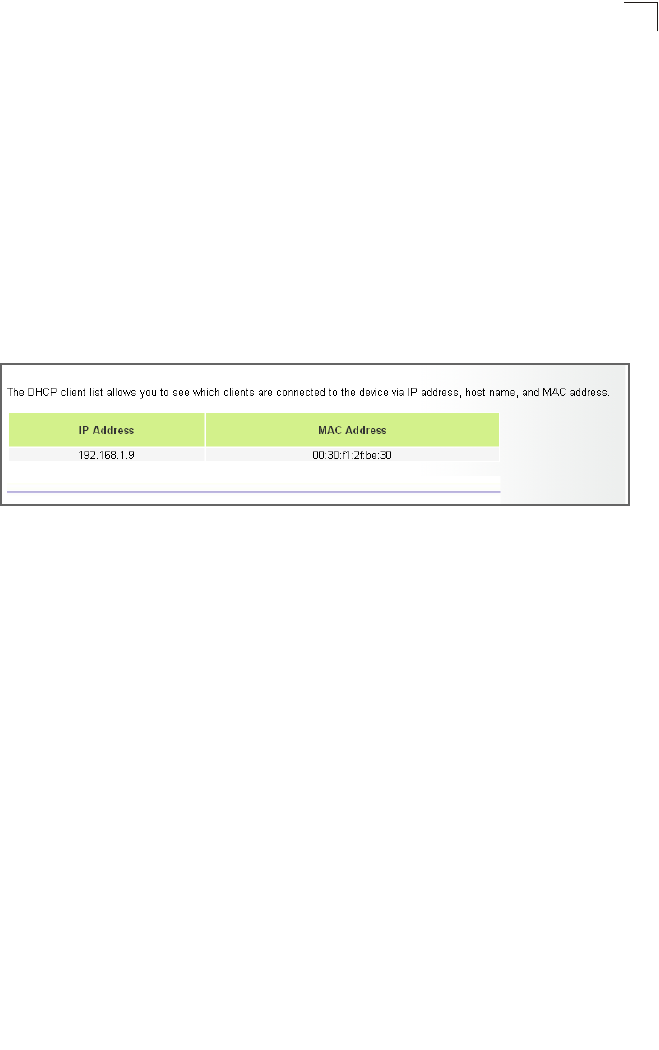
NAT
5-3
5
Lease Time – Selects a time limit for the use of an IP address form the IP pool.
When the time limit expires, the client has to request a new IP address.
(Default: Half hour; Options: Half hour, one hour, two hours, half day, one day,
two days, one week, two weeks)
Local Domain Name – This optional parameter specifies the name of the domain
the unit is attached to.
DHCP Client List
The DHCP Client List page enables you to see the MAC address of devices that are
currently connected to the unit and have been assigned an IP address by the DHCP
server.
Figure 5-2 DHCP Client List
NAT
Network Address Translation (NAT) is a standard method of mapping multiple
"internal" IP addresses to one "external" IP address on devices at the edge of a
network. For the RG230, the internal (local) IP addresses are the IP addresses
assigned to local PCs by the DHCP server, and the external IP address is the IP
address assigned to the WiMAX interface.
Virtual Server
Using the NAT Virtual Server feature, remote users can access different servers on
your local network using your single public IP address.
Remote users accessing services such as web or FTP at your local site thorugh
your public IP address, are redirected (mapped) to other local server IP addresses
and TCP/UDP port numbers. For example, if you set Type/Public Port to TCP/80
(HTTP or web) and the Private IP/Port to 192.168.7.9/80, then all HTTP requests
from outside users forwarded to 192.168.7.9 on port 80. Therefore, by just using
your external IP address provided by your ISP, Internet users can access the
services they need at the local addresses to which you redirect them.
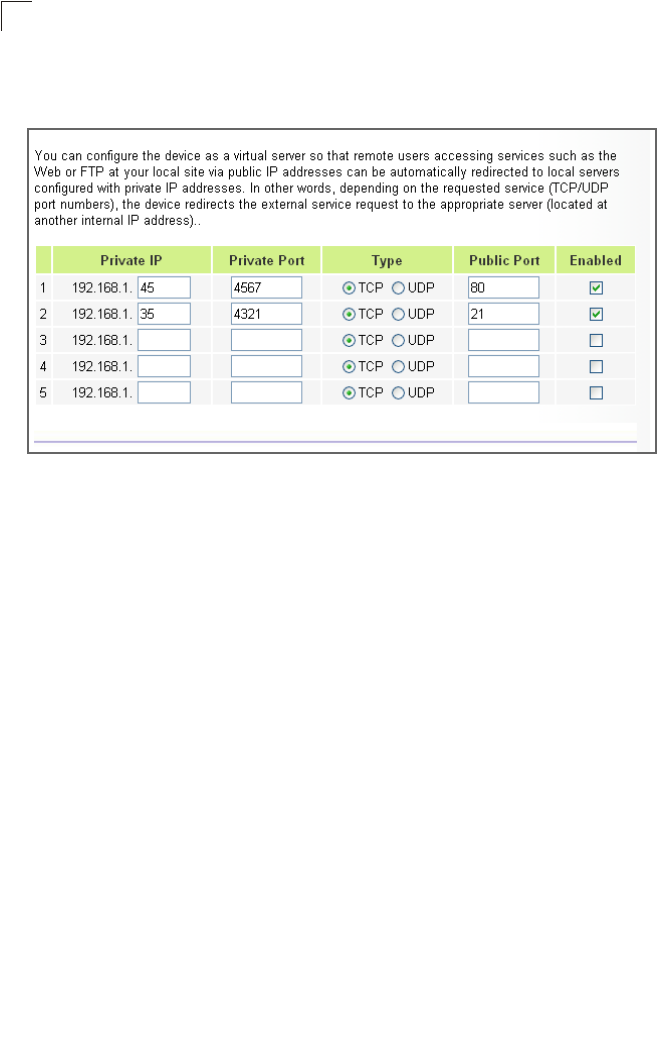
Gateway Configuration
5-4
5
The more common TCP service port numbers include: HTTP: 80, FTP: 21, Telnet:
23, and POP3: 110.
Figure 5-3 Virtual Server
Private IP – The IP address of the server on the local Ethernet network. The
specified address must be in the same subnet as the RG230 and its DHCP server
address pool. (Range: 192.168.1.1 to 192.168.1.254)
Private Port – Specifies the TCP/UDP port number used on the local server for the
service. (Range: 1-65535)
Type – Specifies the port type. (Options: TCP or UDP; Default: TCP)
Public Port – Specifies the public TCP/UDP port used for the service on the WAN
interface. (Range: 1-65535)
Enabled – Enables the virtual server mapping on the specified ports.
(Default: Disabled)
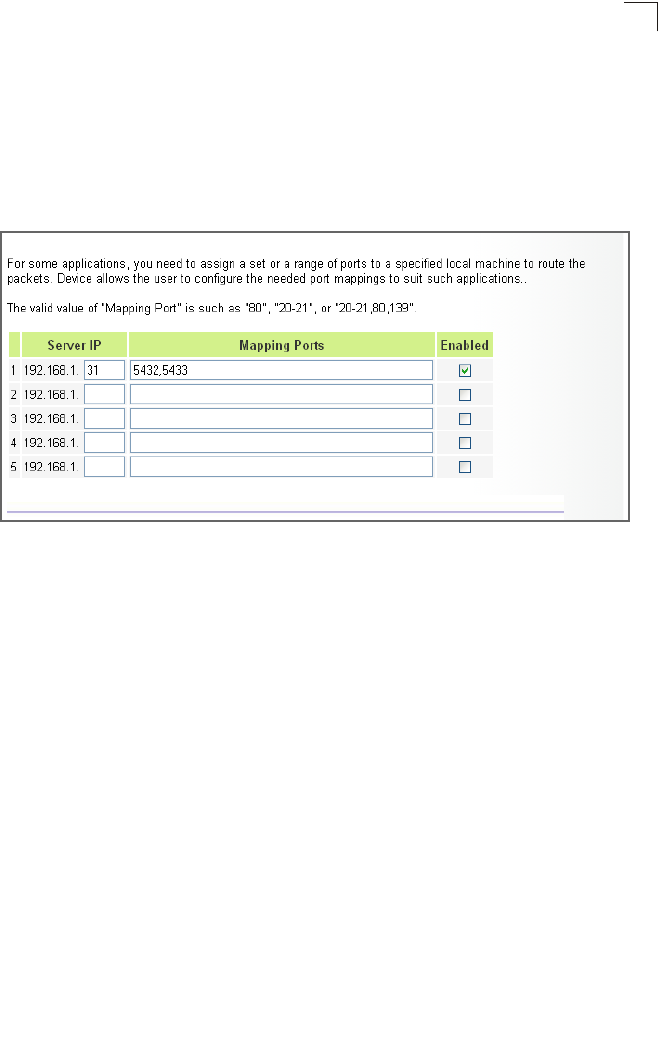
NAT
5-5
5
Port Mapping
Some applications, such as Internet gaming, videoconferencing, Internet telephony
and others, require multiple connections. These applications cannot work with
Network Address Translation (NAT) enabled. If you need to run applications that
require multiple connections, use port mapping to specify the additional public ports
to be opened for each application.
Figure 5-4 Port Mapping
Server IP – The IP address of the local server. (Range: 192.168.1.1 to
192.168.1.254)
Mapping Ports – Specifies the TCP/UDP ports that the application requires. The
ports may be specified individually, in a range, or a combination of both. For
example, 7, 11, 57, 72-96. (Range: 1-65535)
Enabled – Enables port mapping for the specified IP address. (Default: Disabled)
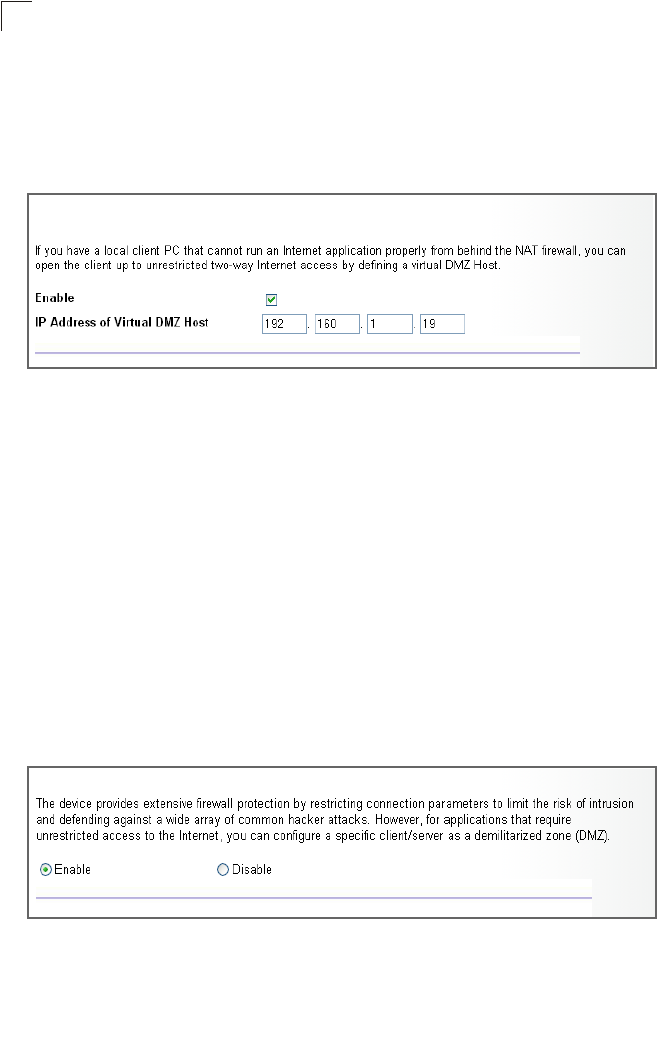
Gateway Configuration
5-6
5
DMZ
If you have a client PC that cannot run an Internet application properly from behind
the NAT firewall, you can open the client up to unrestricted two-way internet access
by defining a virtual-DMZ (virtual-demilitarized-zone) host.
Figure 5-5 DMZ Settings
Enable – Enables the feature. (Default: Disabled)
IP Address of Virtual DMZ Host – Specifies the IP address of the virtual DMZ host.
(Range: 192.168.1.1 to 192.168.1.254; Default: 0.0.0.0)
Note: Adding a host to the DMZ may expose your local network to a variety of security
risks, so only use this option as a last resort.
Firewall
The RG230 provides extensive firewall protection by restricting connection
parameters to limit the risk of intrusion and defending against a wide array of
common hacker attacks. You can also block access to the Internet from clients on
the local network based on IP addresses and TCP/UDP port numbers, or specific
MAC addresses.
Figure 5-6 Firewall Setting
Enable – Enables the feature.
Disable – Disables the feature. (This is the default.)
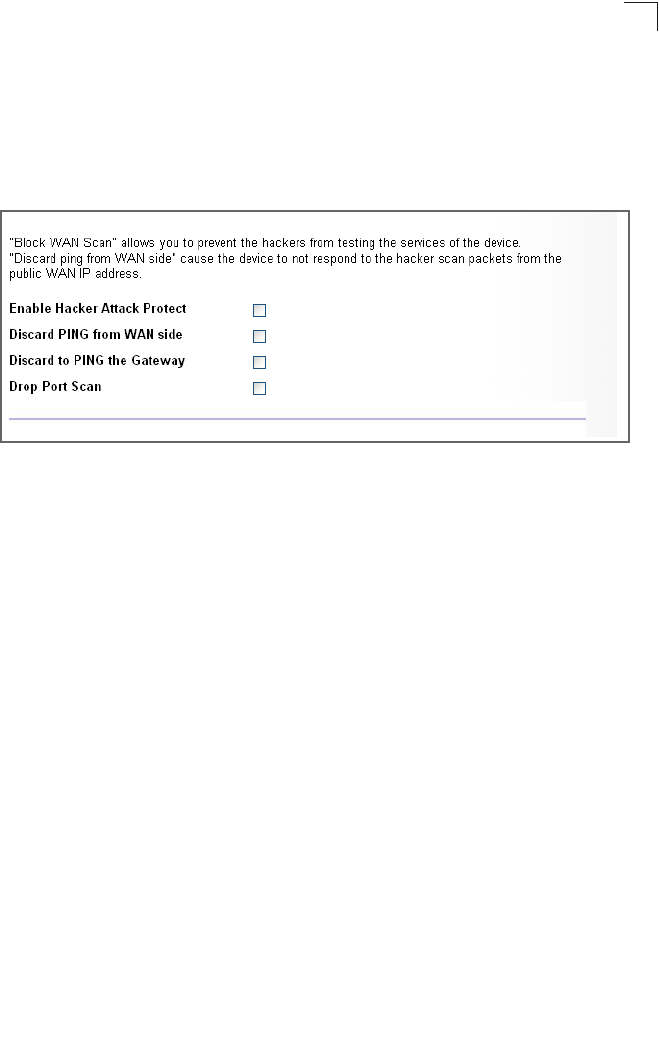
Firewall
5-7
5
Firewall Options
The RG230’s firewall enables access control of client PCs, blocks common hacker
attacks, including IP Spoofing, Land Attack, Ping of Death, Smurf Attack, TCP null
scan, ICMP defect, and TCP SYN flooding. The firewall does not significantly affect
system performance and it is best to leave it enabled to protect your network.
Figure 5-7 Firewall Options
Enable Hacker Attack Protect – Network attacks that deny access to a network
device are called DoS attacks. DoS attacks are aimed at devices and networks with
a connection to the Internet. Their goal is not to steal information, but to disable a
device or network so users no longer have access to network resources. The Router
protects against the following DoS attacks: IP Spoofing, Land Attack, Ping of Death,
Smurf Attack, TCP null scan, ICMP defect, and TCP SYN flooding.
Discard PING from WAN side – Prevents pings on the unit’s WiMAX interface from
being routed to the network.
Discard to PING the Gateway – Prevents any response to a ping to the unit’s IP
address.
Drop Port Scan – Prevents outside hackers form testing the TCP/UDP port
numbers on the unit for any services.
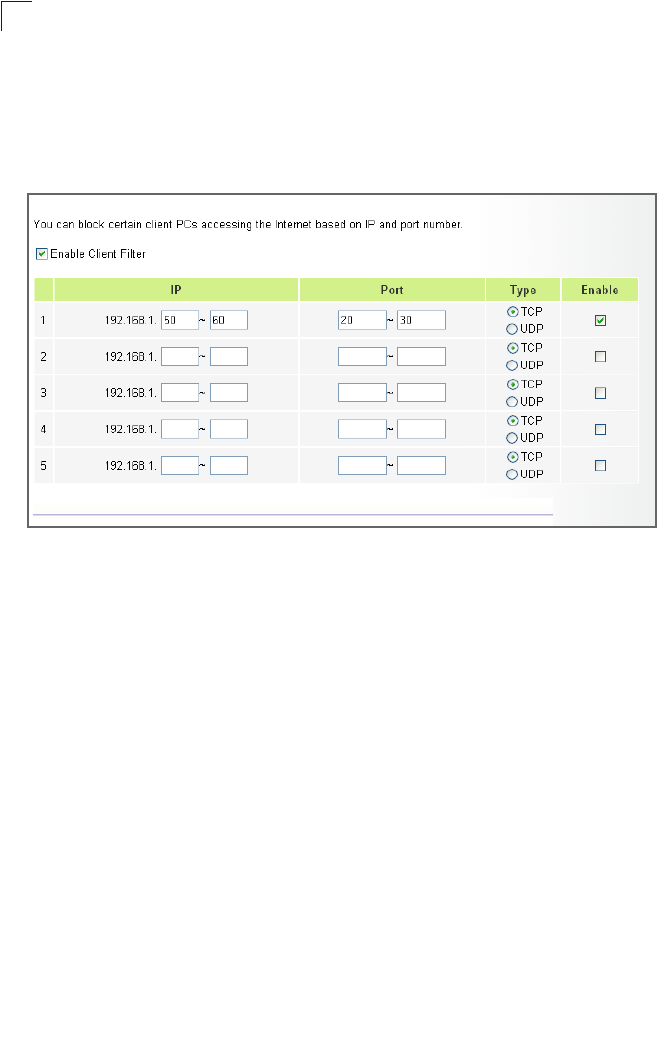
Gateway Configuration
5-8
5
Client Filtering
You can block access to the Internet from clients on the local network by specifying
IP addresses and TCP/UDP port numbers. You can configure up to five IP filters on
the unit.
Figure 5-8 Client Filtering Settings
Enable Client Filter – Enables client filtering for entries in the table.
(Default: Disabled)
IP – Specifies an IP address or range on the local network. (Range: 192.168.1.1 to
192.168.1.254)
Port – Specifies a TCP/UDP port number range to filter. (Range: 1-65535)
Type – Specifies the the port type. (Options: TCP or UDP; Default: TCP)
Enable – Enables filtering for the table entry. (Default: Disabled)
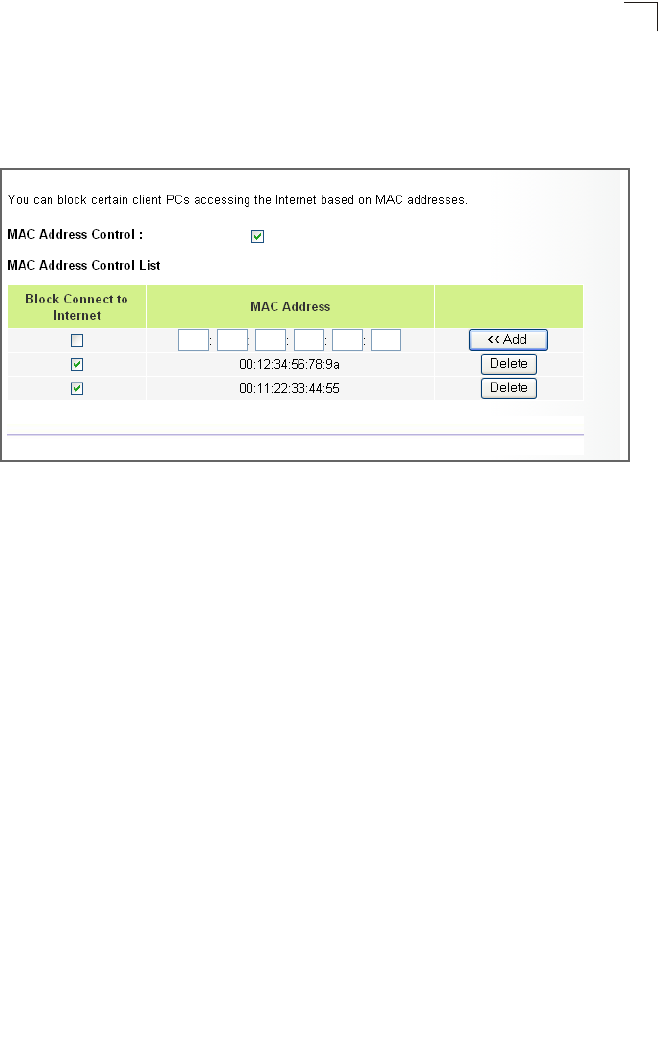
Firewall
5-9
5
MAC Control
You can block access to the Internet from clients on the local network by MAC
addresses. You can configure up to 20 MAC address filters on the unit.
Figure 5-9 MAC Control
MAC Address Control – Enables the feature. (Default: Enabled)
Block Connect to Internet – Blocks Internet access for the scpecified MAC
address. (Default: Enabled)
MAC Address – Specifies a local PC MAC address.
Add – Adds a new MAC address to the filter table.
Delete – Removes a MAC address from the filter table.
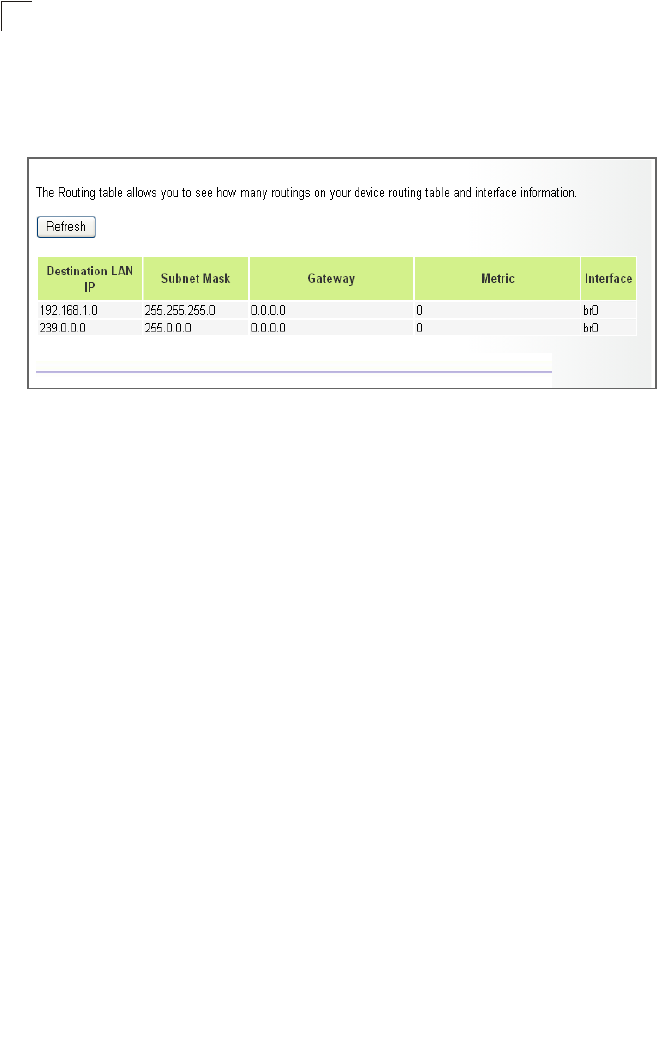
Gateway Configuration
5-10
5
Route
The
Routing Table displays the list of static routes on the unit.
Figure 5-10 Routing Table
Destination LAN IP – The IP address that identifies the IP subnet of the remote
network.
Subnet Mask – The mask that identifies the IP subnet of the remote network.
Gateway – The IP address of the router within the local IP subnet that forwards
traffic to the remote IP subnet.
Metric – Cost for the local interface. This cost is only used when routes are imported
by a dynamic routing protocol.
Interface – Indicates the local network interface on the unit.
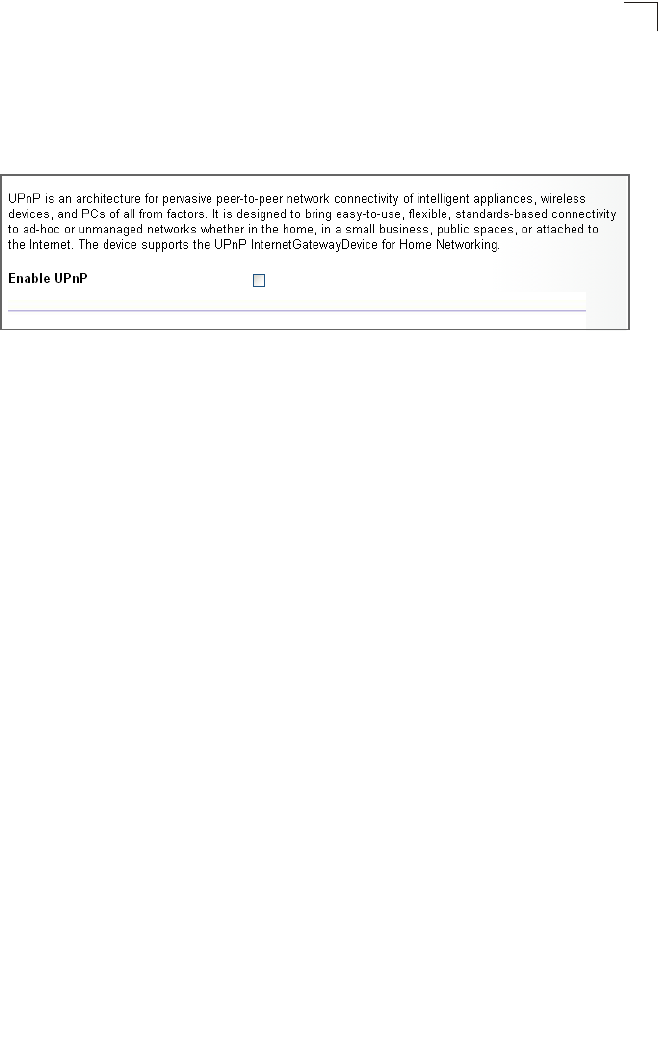
UPnP
5-11
5
UPnP
UPnP (Universal Plug and Play Forum) provides inter-connectivity between devices
supported by the same standard.
Figure 5-11 UPnP Setting
UPnP – Enables UpnP support on the unit. (Default: Disabled)

Gateway Configuration
5-12
5
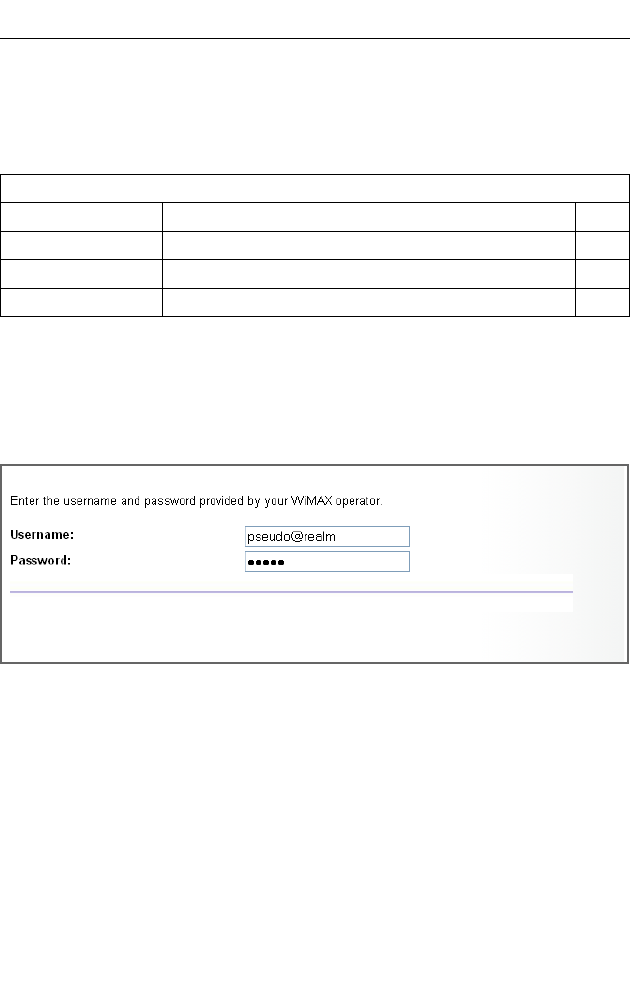
6-1
Chapter 6: WiMAX Settings
The RG230’s WiMAX menu enables you to configure WiMAX network user
authentication, view subscriber station information, and select an operating antenna.
The WiMAX pages include the following options.
User Account Settings
Configures user account authentication settings for connection to the WiMAX
network.
Figure 6-1 WiMAX Account Settings
User Name – The user name required for authentication as provided by the WiMAX
operator. (Default: pseudo@realm)
Password – The user password required for authentication as provided by the
WiMAX operator. (Default: hello)
Table 6-1 WiMAX Settings
Menu Description Page
Account Configures WiMAX network user authentication 6-2
SSinfo Displays subscriber station information for the unit 6-2
Antenna Setting Configures use of internal or external antennas 6-3
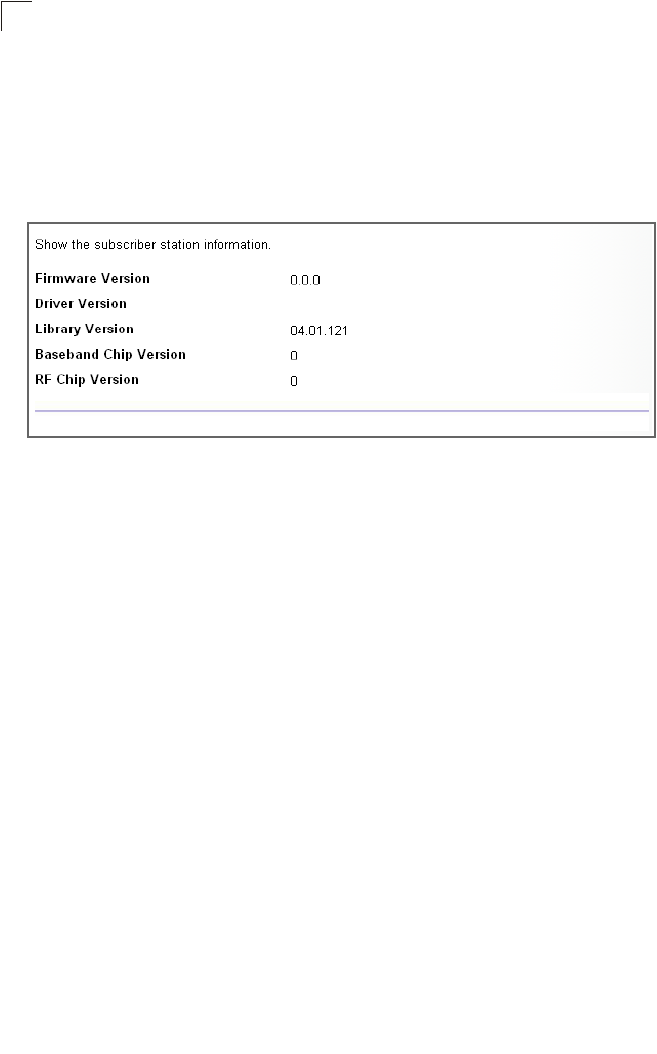
WiMAX Settings
6-2
6
Subscriber Station Information
The SSInfo page displays information about the software versions on the RG230
unit.
Note: The current WiMAX connection status is described under the section “Home
Page” on page 3-2.
Figure 6-2 Subscriber Station Information
Firmware Version – The version of software code running on the unit.
Driver Version – The version of the WiMAX chip driver software.
Library Version – The version of WiMAX library software.
Baseband Chip Version – The version of the WiMAX baseband chip.
RF Chip Version – The version of the WiMAX radio chip.
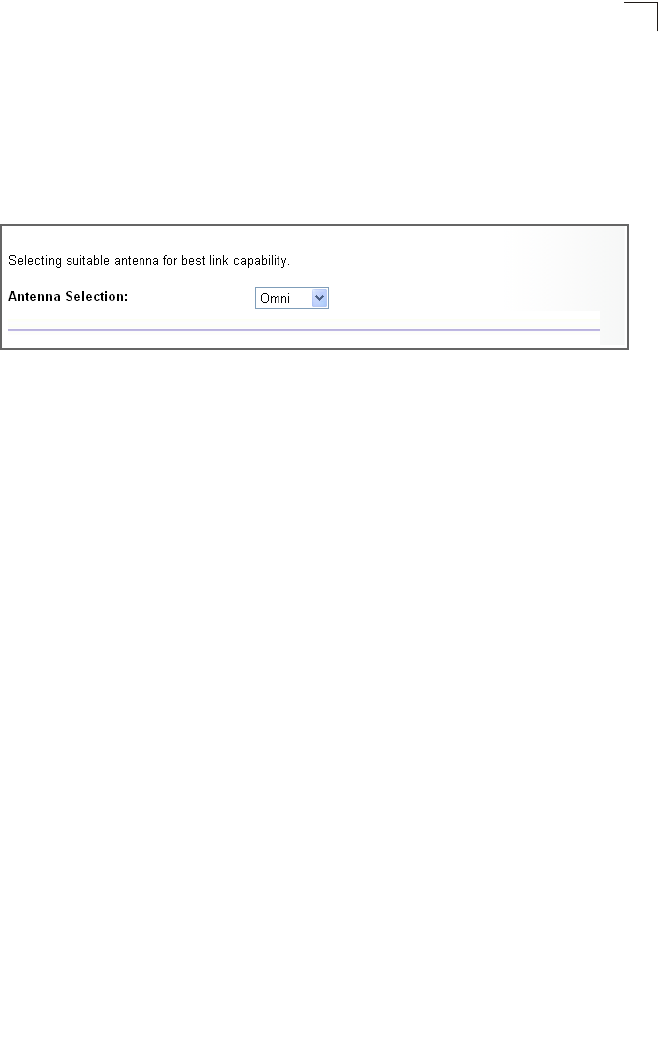
Antenna Setting
6-3
6
Antenna Setting
The RG230 provides the option of using an external antenna instead of the
omnidirectional antennas supplied with the unit.
Note: External antennas are not currently supported on the RG230. The only valid
setting is “Omni.”
Figure 6-3 WiMAX Antenna Setting

WiMAX Settings
6-4
6

7-1
Chapter 7: VoIP Settings
Voice over Internet Protocol (VoIP) technology is a way of using the Internet to make
phone calls. Phone calls can be tranmitted over the Internet by encoding a voice call
into data packets at one end and then decoding it back into voice calls at the other
end. This encoding and decoding is from a analog signal (your voice) into a digital
signal (data packets) and then back into an analog signal.
The RG230 uses Session Initiation Protocol (SIP) as the control mechanism that
sets up, initiates, and terminates calls between a caller and a called party. The SIP
messaging makes use of “Proxy,” “Redirect,” and “Registration” servers to process
call requests and find the location of called parties across the Internet. When SIP
has set up a call between two parties, the actual voice communication is a direct
peer-to-peer connection using the standard Real-Time Protocol (RTP), which
streams the encoded voice data across the network.
You can make VoIP calls by connecting a regular phone to one of the RG230’s
RJ-11 Phone ports. You can also make VoIP calls from your computer using a VoIP
application with a simple microphone and computer speakers. Using either method,
VoIP provides an experience identical to normal telephoning.
The RG230 allows the two RJ-11 Phone ports to be configured separately with
different settings.
The VoIP configuration pages include the following options.
Table 7-1. VoIP Settings
Menu Description Page
SIP Account Shows the basic SIP account details for Phone 1 and Phone 2 7-3
Dial Plan Sets control strings for dialed phone numbers 7-3
Call Feature Configures call forwarding options
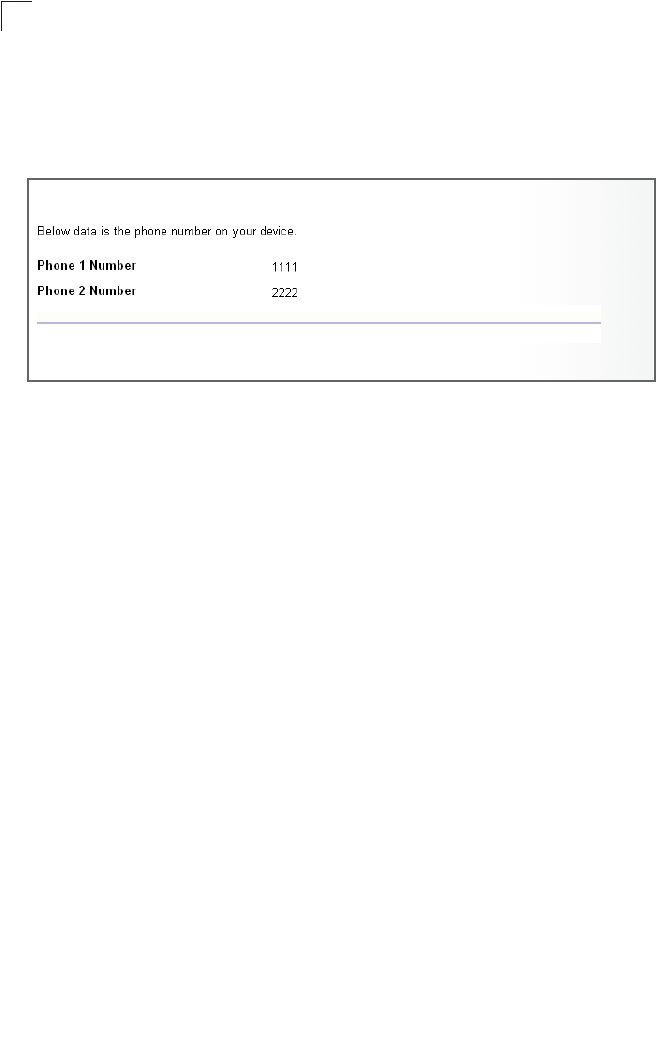
VoIP Settings
7-2
7
SIP Account
From the VoIP SIP Account page, you can view the SIP account numbers that have
been provided by the service operator.
Figure 7-1 SIP Account Settings
Phone 1 Number – The first SIP account user number provided by the service
operator.
Phone 2 Number – The second SIP account user number provided by the service
operator.
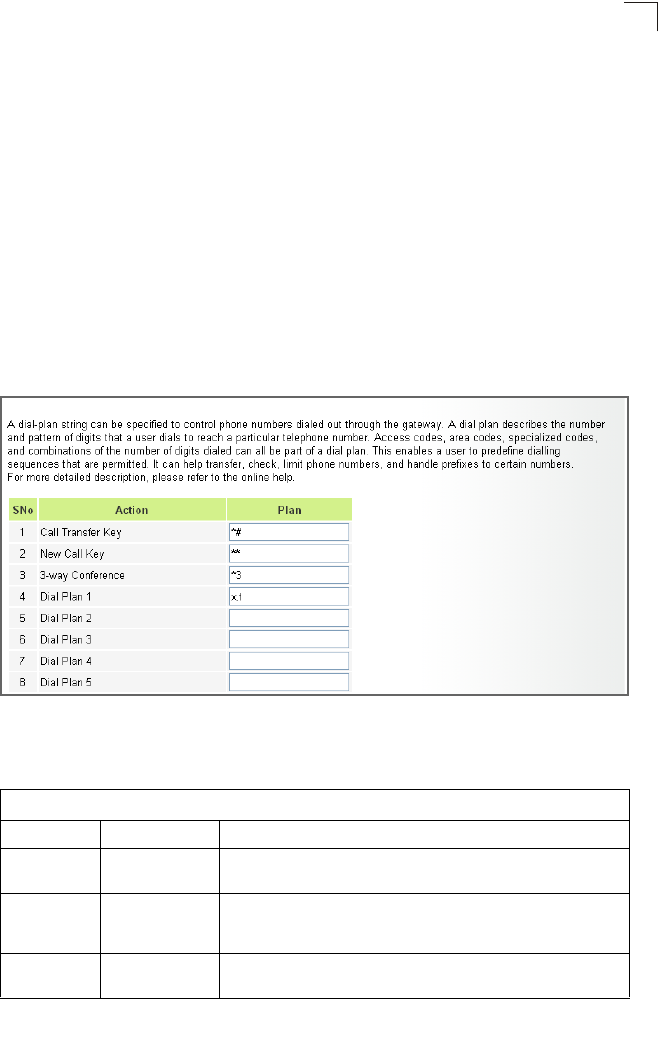
Dial Plan
7-3
7
Dial Plan
Dial-plan strings specify key sequences used for specific calling features (Transfer,
New Call, 3-way conference), as well as defining call restriction filters.
A dial plan can filter the number and pattern of digits that a user dials to reach a
particular telephone number. Access codes, area codes, specialized codes, and
combinations of the number of digits dialed can all be part of a dial plan. This
enables a user to predefine dialling sequences that are permitted.
The dial-plan string consists of a single digit rule. A typical example of a dial-plan
string is: [0123]xxxxxx.t
Three standard dial plans are defined; Call Transfer Key, New Call Key, and 3-way
Conference. Up to 10 other dial plans can be defined by the user.
Figure 7-2 Dial Plan Settings
The function of elements allowed in a dial plan are described in the table below:
Table 7-1. Dial Plan Elements
Element Example Description
x xxxx Represents a digit of any value ( 0 to 9) that can be dialed on a
phone. This example has a rule with four digits of any number.
. xx. Indicates zero or more occurrences of the previous symbol. The
example acts like a wildcard, meaning any dialed phone number of
two or more digits is allowed.
0-9 01xx Indicates dialed digits that must be matched. This example only
allows four-digit numbers starting “01.”

VoIP Settings
7-4
7
When a user dials a series of digits, the dial-plan rule is tested for a possible match.
If a match is made, the dialed sequence is transmitted. If no match is made, the
dialed number is blocked and the user will hear an error tone.
A dial-plan string cannot include spaces between elements. Dialed sequences that
are longer than specified in a dial-plan rule are truncated after the number of
specified digits. For example, if the dial-plan rule is “011x” and “0115678” is dialed,
only the digit sequence “0115” is transmitted.
[ ] [125-8] Limits a dialed digit to specified values or a range of values. The
example specifies that only digits 1, 2, 5, 6, 7, and 8 are permitted.
t xx.t The timeout indicator that can placed after dialed digits or at the end
of the dial-plan string.
Table 7-1. Dial Plan Elements
Element Example Description

Call Feature
7-5
7
Call Feature
The RG230 allows you to configure several call features, such as call waiting and
call-forwarding. Other call features can be implemented by pressing specific phone
buttons or entering dial patterns.
The table below describes the various call features available.
Note: Some call features may be dependent on support at the SIP server. Check with
the SIP service provider.
Table 7-1. VoIP Call Features
Call Feature Description Activation
Call Hold Places an active call on hold for
an unlimited period of time.
Press the “Flash,” “Flash Hook,” or “Hold”
button on the phone.
Call Waiting If during a call there is another
incoming call, an alert tone is
heard.
This feature must first be enabled using the web
interface. You can place the active call on hold
and switch to the incoming call. You can switch
between the two calls by placing the active call
on hold.
Call Switching Calls two numbers, then
switches between them.
Dial the first number, then place it on hold. Dial
the key sequence “**” and wait until you hear
the dial tone, then dial the second number.
Placing the active call on hold switches to the
other call. If the active call is hung up, the phone
rings again to activate the other call.
Call Transfer Transfers any received call to
another number you specify.
First place the received call on hold, then dial
the transfer key sequence “*#”. When you hear
a dial tone, enter the transfer phone number,
then hang up.
Call Forward Forwards an incoming call to
another number.
This feature can be configured using the web
interface. You can specify forwarding numbers
for all calls, when busy, or for no answer.
3-Way Conference Calls two numbers, then allows
all to talk together.
Dial the first number, then place it on hold. Dial
the key sequence “**” and wait until you hear
the dial tone, then dial the second number.
When the second call is active, dial “*3” to
establish the three-way conference.
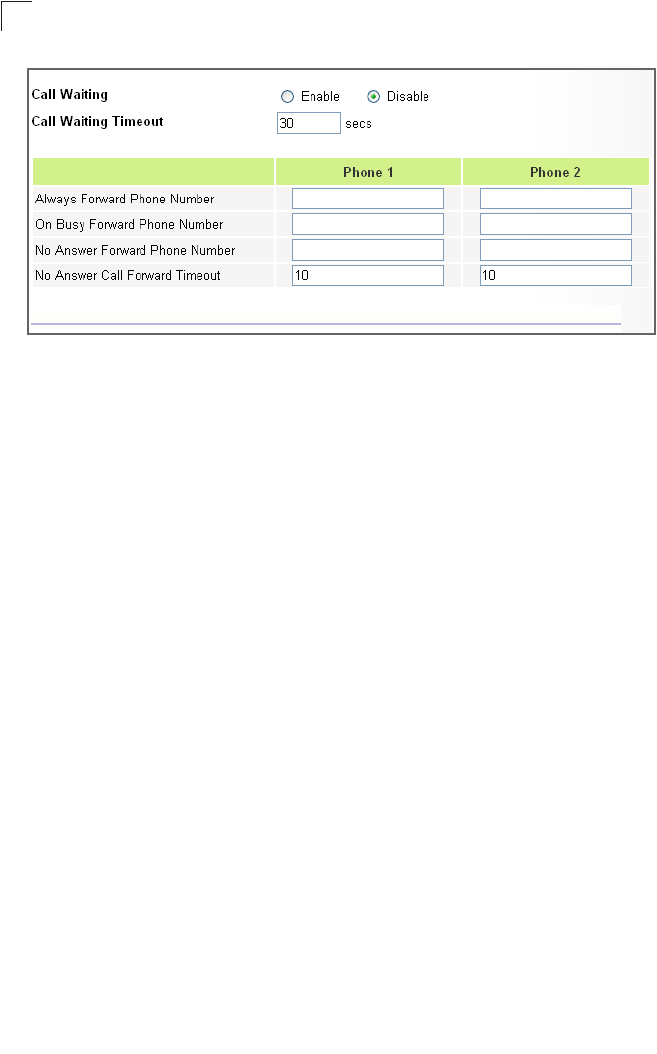
VoIP Settings
7-6
7
Figure 7-3 Call Features
Call Waiting – Enables a call waiting alert. If during a call there is another incoming
call, an alert tone is heard. You can place the active call on hold (press the “Flash,”
“Flash Hook,” or “Hold” button on the phone) and switch to the incoming call.
(Default: Disabled)
Call Waiting Timeout – The time a second incoming call waits before a “no answer”
message is sent. (Range: Must be less than or equal to the value of Answer
Timeout; Default: 30 seconds)
Always Forward Phone Number – Another phone number to which all incoming
calls are forwarded.
On Busy Forward Phone Number – Another phone number to which incoming
calls are forwarded when the phone is busy.
No Answer Forward Phone Number – Another phone number to which incoming
calls are forwarded when there is no answer.
Call Forward No Answer Timeout – The time a call waits for an answer before
being forwarded to the No Answer Forward Phone Number. (Range: Must be less
than or equal to the value of Answer Timeout; Default: 10 seconds)

A-1
Appendix A: Troubleshooting
Diagnosing LED Indicators
Cannot Connect to the Internet
If you cannot access the Internet from the PC, check the following:
• If you cannot access the Internet, be sure your WIndows system is correctly
configured for TCP/IP. The IP settings should be set to “obtain an IP address
automatically.”
• You may be out of the service area of the WiMAX network. Check with the WiMAX
service provider for service coverage information.
•If you cannot resolve the problem, check the System Status page of the web interface
and contact your WiMAX service provider.
Cannot Access Web Management
If the management interface cannot be accessed using a web browser:
• Be sure the management station is correctly configured for TCP/IP. The IP settings
should be set to “obtain an IP address automatically.”
• Try a Ping command from the management station to the unit’s IP address to verify
that the entire network path between the two devices is functioning correctly.
Table A-1 Troubleshooting Chart
Symptom Action
Power LED is Off • AC power adapter may be disconnected. Check connections between
the unit, the AC power adapter, and the wall outlet.
Power LED is Red • The unit has detected a system error. Reboot the unit to try and clear
the condition.
• If the condition does not clear, contact your local dealer for assistance.
WiMAX Signal LEDs are Off • Move the location of the unit.
• Check with the WiMAX service provider for service coverage
information.
LAN link LED is Off • Verify that the unit and attached device are powered on.
• Be sure the cable is plugged into both the unit and corresponding
device.
• Verify that the proper cable type is used and its length does not exceed
specified limits.
• Check the cable connections for possible defects. Replace the
defective cable if necessary.

Troubleshooting
A-2
A
• Check that the management station has a valid network connection and that the
Ethernet port that you are using has not been disabled.
• Check the network cabling between the management station and the unit. If the
problem is not resolved, try using a different port or a different cable.
Forgot or Lost the Password
Set the unit to its default configuration by pressing the reset button on the back
panel for 5 seconds or more. Then use the default password “admin” to access the
management interface.
Resetting the Unit
If all other recovery measures fail and the unit is still not functioning properly, take
either of these steps:
• Reset the unit using the web interface, or through a power reset.
• Reset the unit to its factory default configuration by pressing the reset button on the
back panel for 5 seconds or more. Then use the default password “admin” to
access the management interface.

B-1
Appendix B: Specifications
Physical Specifications
Ports
4 LAN ports, 10/100BASE-TX with auto-negotiation, RJ-45 connector
(Optional) 2 FXS ports (PHONE1, PHONE2), RJ-11 connector
Network Interface
RJ-45 connector, auto MDI/X:
10BASE-T: RJ-45 (100-ohm, UTP cable; Category 3 or better)
100BASE-TX: RJ-45 (100-ohm, UTP cable; Category 5 or better)
LED Indicators
System: Power, WiMAX signal strength, WiFi
Ports: Link/Activity
AC Power Adapter
Input: 100-240 VAC, 50-60 Hz, 1.6 A
Output: 19 VDC, 3.42 A
Unit Power Supply
DC Input: 19 VDC, 1 A maximum
Power Consumption: 11 W maximum
Physical Size
169 x 184 x 80 mm (6.65 x 7.24 x 3.15 in)
Weight
1.2 kg (2.65 lbs)
Temperature
Operating: -5 to 40 °C (23 to 104 °F)
Storage: -40 to 75 °C (-40 to 167 °F)
Humidity
5% to 95% (non-condensing)

Specifications
B-2
B
WiMAX Specifications
Antennas
Omnidirectional:
Included dual dipole antennas
Transmit: Single antenna
Receive: Two antennas using Maximal-Ratio Combining (MRC)
Gain: 5 dBi at 2.5 GHz, 4 dBi at 3.5 GHz
Impedance: 50 Ohm
Operating Frequency
ETSI: 3.4–3.6 GHz
FCC-2.3: 2305-2320 MHz, 2345-2360 MHz
FCC-2.5: 2483.5-2690 MHz
The operation methods and device behavior from 2483.5 MHz to 2500 MHz, which
has only one channel at 2490 MHz and a channel bandwidth of 10 MHz for
Globalstar/Open Range with Part 25 application are the same with Part 27.
No specific function or behavior is enabled while setting operating frequency to
2490 MHz.
Taiwan NCC: 2500-2690 MHz
Support for Full Scan and Partial Scan
Channel Bandwidth
5, 7, 8.75, or 10 MHz depending on model (software configurable)
2.3 GHz Model: 5, 8.75, and 10 MHz
2.5 GHz Model: 5 and 10 MHz
3.5 GHz Model: 5, 7, and 10 MHz
Modulation Scheme
Scaleable OFDMA employing Time-Division Duplex (TDD) mechanism
PRBS subcarrier randomization
Contains pilot, preamble, and ranging modulation
Modulation and Coding Types
Down Link: QPSK, 16 QAM, 64 QAM
Up Link: QPSK, 16 QAM
Receive Sensitivity
-94 dBm maximum

VoIP Specifications
B-3
B
VoIP Specifications
Voice Signaling Protocol
SIP v2 (RFC 3261)
Voice Codec
G.711 (a-law and u-law)
G. 7 2 6
G.729ab
G.723.1
Voice Quality
VAD (Voice Activity Detection)
CNG (Comfortable Noise Generation)
Echo cancellation (G.165/G.168)
Adaptive jitter buffer, up to 200 milliseconds
DTMF tone detection and generation
Call Features
Call transfer
Call waiting/hold/retrieve
3-way conference call
Call blocking
T. 3 8 f a x r e la y
Dial plan (E.164 dialing plan)
Call forwarding: No Answer/Busy/All
REN (Ring Equivalent Number)
3 REN total in system
Compliances
Emissions
FCC CFR 47 Part 15 Class B
EN 55022 class B
EN 301 489-1/4/17
Emmunity
EN 61000-4-2/3/4/5/6/8/11
WiMAX Radio Signal Certification
US: 2.3 GHz - FCC CFR 47 Part 27D; 2.5 GHz - CFR 47 Part 27M
US: 2.5 GHz - CFR 47 Part 25.254 for ATC frequency band
Europe (3.5 GHz): EN 302 326-2 (V1.2.2), EN 302 326-3 (V1.2.2)

Specifications
B-4
B
Wi-Fi Radio Signal Certification
FCC CFR 47 Part 15 Subpart C
EN 300 328
Safety
cTUVus + TUV/SUD
Standards
IEEE 802.16e-2005 WAVE 1 and WAVE 2
IEEE 802.3-2005 10BASE-T and 100BASE-TX
IEEE 802.11b and 802.11g
UPnP

C-1
Appendix C: Cables and Pinouts
Twisted-Pair Cable Assignments
For 10/100BASE-TX connections, a twisted-pair cable must have two pairs of wires.
Each wire pair is identified by two different colors. For example, one wire might be
green and the other, green with white stripes. Also, an RJ-45 connector must be
attached to both ends of the cable.
Caution: Each wire pair must be attached to the RJ-45 connectors in a specific
orientation. (See “Straight-Through Wiring” on page C-2 and “Crossover
Wiring” on page C-2 for an explanation.)
Caution: DO NOT plug a phone jack connector into the RJ-45 port. Use only twisted-pair
cables with RJ-45 connectors that conform with FCC standards.
The following figure illustrates how the pins on the RJ-45 connector are numbered.
Be sure to hold the connectors in the same orientation when attaching the wires to
the pins.
Figure C-1 RJ-45 Connector
10/100BASE-TX Pin Assignments
Use unshielded twisted-pair (UTP) or shielded twisted-pair (STP) cable for RJ-45
connections: 100-ohm Category 3 or better cable for 10 Mbps connections, or
100-ohm Category 5 or better cable for 100 Mbps connections. Also be sure
that the
length of any twisted-pair connection does not exceed 100 meters (328 feet).
The RJ-45 ports on the unit supports automatic MDI/MDI-X operation, so you can
use straight-through or crossover cables for all network connections to PCs,
switches, or hubs. In straight-through cable, pins 1, 2, 3, and 6, at one end of the
cable, are connected straight through to pins 1, 2, 3, and 6 at the other end of the
cable.
1
881
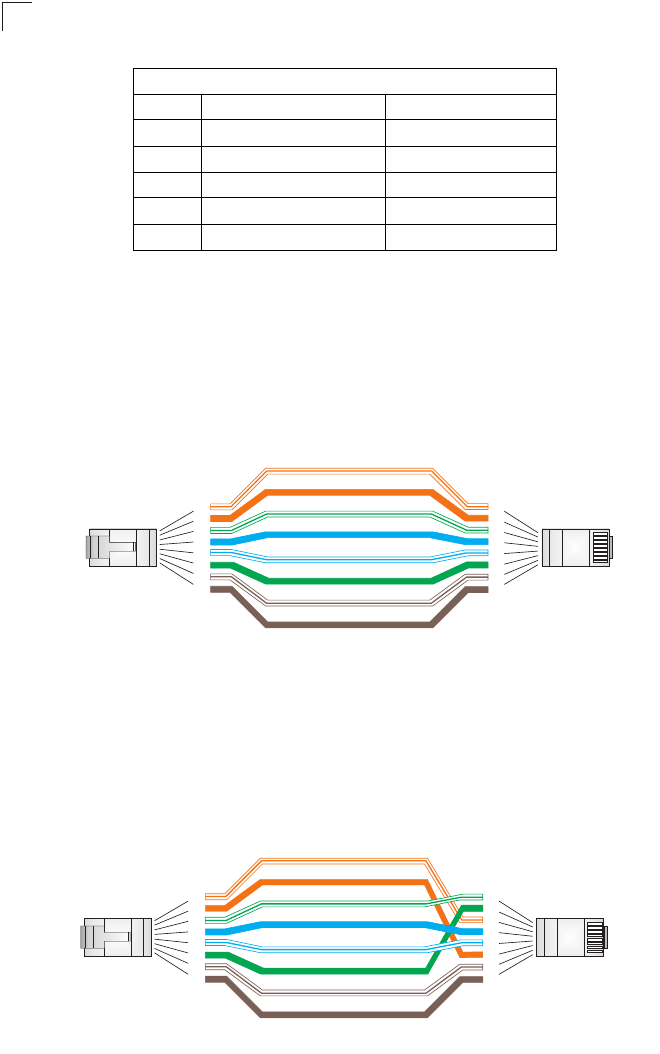
Cables and Pinouts
C-2
C
Straight-Through Wiring
If the twisted-pair cable is to join two ports and only one of the ports has an internal
crossover (MDI-X), the two pairs of wires must be straight-through.
Figure C-2 Straight-Through Wiring
Crossover Wiring
If the twisted-pair cable is to join two ports and either both ports are labeled with an
“X” (MDI-X) or neither port is labeled with an “X” (MDI), a crossover must be
implemented in the wiring.
Figure C-3 Crossover Wiring
Table C-1. 10/100BASE-TX MDI and MDI-X Port Pinouts
Pin MDI-X Signal Name MDI Signal Name
1 Receive Data plus (RD+) Transmit Data plus (TD+)
2 Receive Data minus (RD-) Transmit Data minus (TD-)
3Transmit Data plus (TD+) Receive Data plus (RD+)
6Transmit Data minus (TD-) Receive Data minus (RD-)
4,5,7,8 Not used Not used
Note: The “+” and “-” signs represent the polarity of the wires that make
up each wire pair.
White/Orange Stripe
Orange
White/Green Stripe
Green
1
2
3
4
5
6
7
8
1
2
3
4
5
6
7
8
EIA/TIA 568B RJ-45 Wiring Standard
10/100BASE-TX Straight-through Cable
End A End B
Blue
White/Blue Stripe
Brown
White/Brown Stripe
White/Orange Stripe
Orange
White/Green Stripe
1
2
3
4
5
6
7
8
1
2
3
4
5
6
7
8
EIA/TIA 568B RJ-45 Wiring Standard
10/100BASE-TX Crossover Cable
End A End B
Green
Blue
White/Blue Stripe
Brown
White/Brown Stripe
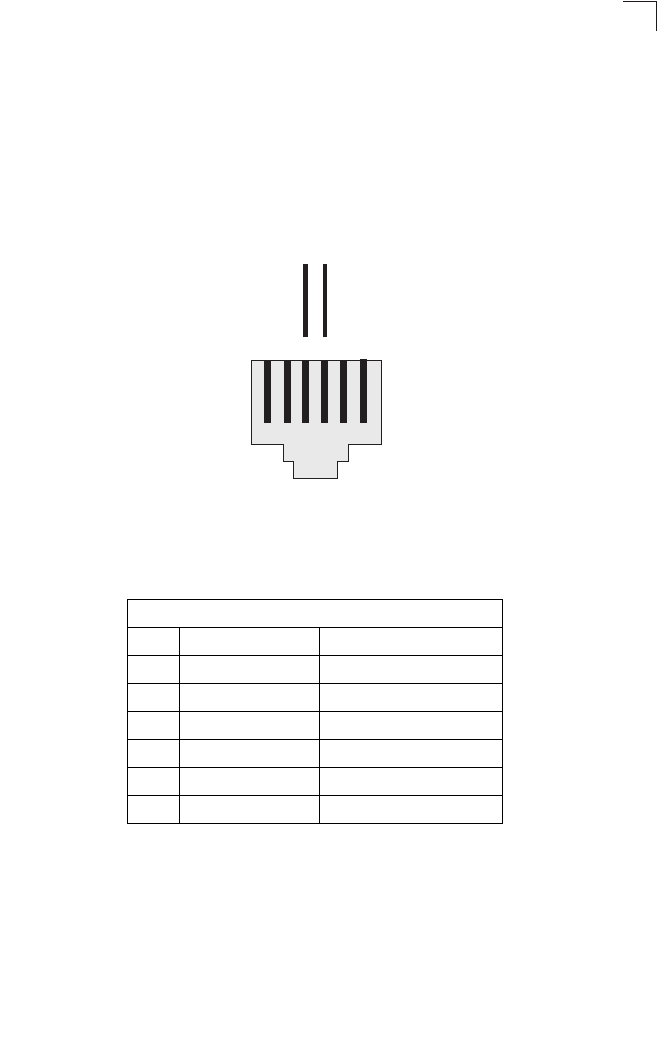
RJ-11 Ports
C-3
C
RJ-11 Ports
Standard telephone RJ-11 connectors and cabling can be found in several common
wiring patterns. These six-pin connectors can accommodate up to three wire pairs
(three telephone lines), but usually only one or two pairs of conductor pins and wires
are implemented.
The RJ-11 ports on this device contain only one wire pair on the inner pins (3 and 4).
Figure C-4 RJ-11 Port Pinout
Table C-2. RJ-11 Port Pinout
Pin Signal Name Wire Color
1Not used
2Not used
3Line 1 Ring Red or Blue/White
4Line 1 Tip Green or White/Blue
5Not used
6Not used
123456
Red or
Blue/White
Green or
White/Blue
RT
R = Ring T = Tip

Cables and Pinouts
C-4
C

D-1
Appendix D: License Information
This product includes copyrighted third-party software subject to the terms of the
GNU General Public License (GPL), GNU Lesser General Public License (LGPL), or
other related free software licences. The GPL code used in this product is distributed
WITHOUT ANY WARRANTY and is subject to the copyrights of one or more
authors. For details, refer to the section “The GNU General Public License” below, or
refer to the applicable licence as included in the source-code archive.
The GNU General Public License
GNU GENERAL PUBLIC LICENSE
Version 2, June 1991
Copyright (C) 1989, 1991 Free Software Foundation, Inc.
59 Temple Place, Suite 330, Boston, MA 02111-1307 USA
Everyone is permitted to copy and distribute verbatim copies of this license
document, but changing it is not allowed.
Preamble
The licenses for most software are designed to take away your freedom to share
and change it. By contrast, the GNU General Public License is intended to
guarantee your freedom to share and change free software--to make sure the
software is free for all its users. This General Public License applies to most of the
Free Software Foundation's software and to any other program whose authors
commit to using it. (Some other Free Software Foundation software is covered by
the GNU Library General Public License instead.) You can apply it to your
programs, too.
When we speak of free software, we are referring to freedom, not price. Our
General Public Licenses are designed to make sure that you have the freedom to
distribute copies of free software (and charge for this service if you wish), that you
receive source code or can get it if you want it, that you can change the software or
use pieces of it in new free programs; and that you know you can do these things.
To protect your rights, we need to make restrictions that forbid anyone to deny you
these rights or to ask you to surrender the rights. These restrictions translate to
certain responsibilities for you if you distribute copies of the software, or if you
modify it.
For example, if you distribute copies of such a program, whether gratis or for a fee,
you must give the recipients all the rights that you have. You must make sure that
they, too, receive or can get the source code. And you must show them these terms
so they know their rights.

License Information
D-2
D
We protect your rights with two steps: (1) copyright the software, and (2) offer you
this license which gives you legal permission to copy, distribute and/or modify the
software.
Also, for each author's protection and ours, we want to make certain that everyone
understands that there is no warranty for this free software. If the software is
modified by someone else and passed on, we want its recipients to know that what
they have is not the original, so that any problems introduced by others will not
reflect on the original authors' reputations.
Finally, any free program is threatened constantly by software patents. We wish to
avoid the danger that redistributors of a free program will individually obtain patent
licenses, in effect making the program proprietary. To prevent this, we have made it
clear that any patent must be licensed for everyone's free use or not licensed at all.
The precise terms and conditions for copying, distribution and modification follow.
GNU GENERAL PUBLIC LICENSE TERMS AND CONDITIONS FOR COPYING,
DISTRIBUTION AND MODIFICATION
0. This License applies to any program or other work which contains a notice
placed by the copyright holder saying it may be distributed under the terms of
this General Public License. The "Program", below, refers to any such program
or work, and a "work based on the Program" means either the Program or any
derivative work under copyright law: that is to say, a work containing the
Program or a portion of it, either verbatim or with modifications and/or
translated into another language. (Hereinafter, translation is included without
limitation in the term "modification".) Each licensee is addressed as "you".
Activities other than copying, distribution and modification are not covered by
this License; they are outside its scope. The act of running the Program is not
restricted, and the output from the Program is covered only if its contents
constitute a work based on the Program (independent of having been made by
running the Program). Whether that is true depends on what the Program does.
1. You may copy and distribute verbatim copies of the Program's source code as
you receive it, in any medium, provided that you conspicuously and
appropriately publish on each copy an appropriate copyright notice and
disclaimer of warranty; keep intact all the notices that refer to this License and
to the absence of any warranty; and give any other recipients of the Program a
copy of this License along with the Program.
You may charge a fee for the physical act of transferring a copy, and you may at
your option offer warranty protection in exchange for a fee.
2. You may modify your copy or copies of the Program or any portion of it, thus
forming a work based on the Program, and copy and distribute such
modifications or work under the terms of Section 1 above, provided that you
also meet all of these conditions:

The GNU General Public License
D-3
D
a). You must cause the modified files to carry prominent notices stating that
you changed the files and the date of any change.
b). You must cause any work that you distribute or publish, that in whole or in
part contains or is derived from the Program or any part thereof, to be
licensed as a whole at no charge to all third parties under the terms of this
License.
c). If the modified program normally reads commands interactively when run,
you must cause it, when started running for such interactive use in the
most ordinary way, to print or display an announcement including an
appropriate copyright notice and a notice that there is no warranty (or else,
saying that you provide a warranty) and that users may redistribute the
program under these conditions, and telling the user how to view a copy of
this License. (Exception: if the Program itself is interactive but does not
normally print such an announcement, your work based on the Program is
not required to print an announcement.)
These requirements apply to the modified work as a whole. If identifiable
sections of that work are not derived from the Program, and can be reasonably
considered independent and separate works in themselves, then this License,
and its terms, do not apply to those sections when you distribute them as
separate works. But when you distribute the same sections as part of a whole
which is a work based on the Program, the distribution of the whole must be on
the terms of this License, whose permissions for other licensees extend to the
entire whole, and thus to each and every part regardless of who wrote it.
Thus, it is not the intent of this section to claim rights or contest your rights to
work written entirely by you; rather, the intent is to exercise the right to control
the distribution of derivative or collective works based on the Program.
In addition, mere aggregation of another work not based on the Program with
the Program (or with a work based on the Program) on a volume of a storage or
distribution medium does not bring the other work under the scope of this
License.
3. You may copy and distribute the Program (or a work based on it, under Section
2) in object code or executable form under the terms of Sections 1 and 2 above
provided that you also do one of the following:
a). Accompany it with the complete corresponding machine-readable source
code, which must be distributed under the terms of Sections 1 and 2 above
on a medium customarily used for software interchange; or,
b). Accompany it with a written offer, valid for at least three years, to give any
third party, for a charge no more than your cost of physically performing
source distribution, a complete machine-readable copy of the
corresponding source code, to be distributed under the terms of Sections 1
and 2 above on a medium customarily used for software interchange; or,

License Information
D-4
D
c). Accompany it with the information you received as to the offer to distribute
corresponding source code. (This alternative is allowed only for
noncommercial distribution and only if you received the program in object
code or executable form with such an offer, in accord with Subsection b
above.)
The source code for a work means the preferred form of the work for making
modifications to it. For an executable work, complete source code means all
the source code for all modules it contains, plus any associated interface
definition files, plus the scripts used to control compilation and installation of the
executable. However, as a special exception, the source code distributed need
not include anything that is normally distributed (in either source or binary form)
with the major components (compiler, kernel, and so on) of the operating
system on which the executable runs, unless that component itself
accompanies the executable.
If distribution of executable or object code is made by offering access to copy
from a designated place, then offering equivalent access to copy the source
code from the same place counts as distribution of the source code, even
though third parties are not compelled to copy the source along with the object
code.
4. You may not copy, modify, sublicense, or distribute the Program except as
expressly provided under this License. Any attempt otherwise to copy, modify,
sublicense or distribute the Program is void, and will automatically terminate
your rights under this License. However, parties who have received copies, or
rights, from you under this License will not have their licenses terminated so
long as such parties remain in full compliance.
5. You are not required to accept this License, since you have not signed it.
However, nothing else grants you permission to modify or distribute the
Program or its derivative works. These actions are prohibited by law if you do
not accept this License. Therefore, by modifying or distributing the Program (or
any work based on the Program), you indicate your acceptance of this License
to do so, and all its terms and conditions for copying, distributing or modifying
the Program or works based on it.
6. Each time you redistribute the Program (or any work based on the Program),
the recipient automatically receives a license from the original licensor to copy,
distribute or modify the Program subject to these terms and conditions. You
may not impose any further restrictions on the recipients' exercise of the rights
granted herein. You are not responsible for enforcing compliance by third
parties to this License.
7. If, as a consequence of a court judgment or allegation of patent infringement or
for any other reason (not limited to patent issues), conditions are imposed on
you (whether by court order, agreement or otherwise) that contradict the
conditions of this License, they do not excuse you from the conditions of this
License. If you cannot distribute so as to satisfy simultaneously your
obligations under this License and any other pertinent obligations, then as a

The GNU General Public License
D-5
D
consequence you may not distribute the Program at all. For example, if a
patent license would not permit royalty-free redistribution of the Program by all
those who receive copies directly or indirectly through you, then the only way
you could satisfy both it and this License would be to refrain entirely from
distribution of the Program.
If any portion of this section is held invalid or unenforceable under any
particular circumstance, the balance of the section is intended to apply and the
section as a whole is intended to apply in other circumstances.
It is not the purpose of this section to induce you to infringe any patents or other
property right claims or to contest validity of any such claims; this section has
the sole purpose of protecting the integrity of the free software distribution
system, which is implemented by public license practices. Many people have
made generous contributions to the wide range of software distributed through
that system in reliance on consistent application of that system; it is up to the
author/donor to decide if he or she is willing to distribute software through any
other system and a licensee cannot impose that choice.
This section is intended to make thoroughly clear what is believed to be a
consequence of the rest of this License.
8. If the distribution and/or use of the Program is restricted in certain countries
either by patents or by copyrighted interfaces, the original copyright holder who
places the Program under this License may add an explicit geographical
distribution limitation excluding those countries, so that distribution is permitted
only in or among countries not thus excluded. In such case, this License
incorporates the limitation as if written in the body of this License.
9. The Free Software Foundation may publish revised and/or new versions of the
General Public License from time to time. Such new versions will be similar in
spirit to the present version, but may differ in detail to address new problems or
concerns.
Each version is given a distinguishing version number. If the Program specifies
a version number of this License which applies to it and "any later version", you
have the option of following the terms and conditions either of that version or of
any later version published by the Free Software Foundation. If the Program
does not specify a version number of this License, you may choose any version
ever published by the Free Software Foundation.
10. If you wish to incorporate parts of the Program into other free programs whose
distribution conditions are different, write to the author to ask for permission.
For software which is copyrighted by the Free Software Foundation, write to the
Free Software Foundation; we sometimes make exceptions for this. Our
decision will be guided by the two goals of preserving the free status of all
derivatives of our free software and of promoting the sharing and reuse of
software generally.

License Information
D-6
D
NO WARRANTY
11. BECAUSE THE PROGRAM IS LICENSED FREE OF CHARGE, THERE IS NO
WARRANTY FOR THE PROGRAM, TO THE EXTENT PERMITTED BY
APPLICABLE LAW. EXCEPT WHEN OTHERWISE STATED IN WRITING THE
COPYRIGHT HOLDERS AND/OR OTHER PARTIES PROVIDE THE
PROGRAM "AS IS" WITHOUT WARRANTY OF ANY KIND, EITHER
EXPRESSED OR IMPLIED, INCLUDING, BUT NOT LIMITED TO, THE
IMPLIED WARRANTIES OF MERCHANTABILITY AND FITNESS FOR A
PARTICULAR PURPOSE. THE ENTIRE RISK AS TO THE QUALITY AND
PERFORMANCE OF THE PROGRAM IS WITH YOU. SHOULD THE
PROGRAM PROVE DEFECTIVE, YOU ASSUME THE COST OF ALL
NECESSARY SERVICING, REPAIR OR CORRECTION.
12. IN NO EVENT UNLESS REQUIRED BY APPLICABLE LAW OR AGREED TO
IN WRITING WILL ANY COPYRIGHT HOLDER, OR ANY OTHER PARTY
WHO MAY MODIFY AND/OR REDISTRIBUTE THE PROGRAM AS
PERMITTED ABOVE, BE LIABLE TO YOU FOR DAMAGES, INCLUDING
ANY GENERAL, SPECIAL, INCIDENTAL OR CONSEQUENTIAL DAMAGES
ARISING OUT OF THE USE OR INABILITY TO USE THE PROGRAM
(INCLUDING BUT NOT LIMITED TO LOSS OF DATA OR DATA BEING
RENDERED INACCURATE OR LOSSES SUSTAINED BY YOU OR THIRD
PARTIES OR A FAILURE OF THE PROGRAM TO OPERATE WITH ANY
OTHER PROGRAMS), EVEN IF SUCH HOLDER OR OTHER PARTY HAS
BEEN ADVISED OF THE POSSIBILITY OF SUCH DAMAGES.
END OF TERMS AND CONDITIONS

Glossary-1
Glossary
10BASE-T
IEEE 802.3-2005 specification for 10 Mbps Ethernet over two pairs of Category 3 or
better UTP cable.
100BASE-TX
IEEE 802.3-2005 specification for 100 Mbps Fast Ethernet over two pairs of
Category 5 or better UTP cable.
Access Point
An Wi-Fi internetworking device that seamlessly connects wired and wireless
networks.
Authentication
The process to verify the identity of a client requesting network access.
Auto-Negotiation
Signalling method allowing each node to select its optimum operational mode
(speed and duplex mode) based on the capabilities of the node to which it is
connected.
Base Station
A WIMAX service provider’s equipment that is installed at a fixed location to provide
network connectivity for subscriber stations within a defined service area.
Beacon
A signal periodically transmitted from a Wi-Fi access point that is used to identify the
network and maintain contact with wireless clients.
Carrier-to-Interference-Plus-Noise Ratio (CINR)
A measurement of the channel quality in a WiMAX link. Subscriber stations measure
the received CINR and send the information back to the base station. The base
station can then adjust modulation and coding for the link to optimize throughput.
Center Frequency
The radio frequency at the center of a WiMAX channel. WiMAX channels can be of
different widths (the channel bandwidth) and the transmitted radio signal is spread
across the full width of the channel.
Channel Bandwidth
The range of frequencies occupied by a WiMAX radio signal. The amount of
information that can be transmitted in a radio signal is related to the channel

Glossary
Glossary-2
bandwidth, which is measured in Megahertz (MHz). WiMAX supports a range of
channel bandwidths that can be defined by the service operator depending on
performance requirements, operating preferences, and regulatory constraints.
CPE (Customer-Premises Equipment)
Terminal equipment provided by a service provider that is located at a subscriber’s
premises and supports a communication channel between a customer and the
service provider.
Domain Name System (DNS)
A system used for translating host names for network nodes into IP addresses.
Dynamic Host Configuration Protocol (DHCP)
Provides a framework for passing configuration information to hosts on a TCP/IP
network. DHCP is based on the Bootstrap Protocol (BOOTP), adding the capability
of automatic allocation of reusable network addresses and additional configuration
options.
Encryption
Data passing between a base station and subscribers uses encryption to protect
from interception and evesdropping.
Ethernet
A popular local area data communications network, which accepts transmission
from computers and terminals.
Extensible Authentication Protocol (EAP)
An authentication protocol used to authenticate subscribers. EAP is used with TLS
or TTLS authentication to provide “mutual authentication” between a subscriber and
a WiMAX network.
Hypertext Transfer Protocol (HTTP)
HTTP is a standard used to transmit and receive all data over the World Wide Web.
IEEE 802.11b
The Wi-Fi wireless standard that supports communications in the 2.4 GHz band
using Direct Sequence Spread Spectrum (DSSS). The standard provides for data
rates of 1, 2, 5.5, and 11 Mbps.
IEEE 802.11g
The Wi-Fi wireless standard that supports communications in the 2.4 GHz band
using using Orthogonal Frequency Division Multiplexing (OFDM). The standard
provides for data rates of 6, 9, 11, 12, 18, 24, 36, 48, 54 Mbps. IEEE 802.11g is also
backward compatible with IEEE 802.11b.

Glossary-3
Glossary
IEEE 802.16e
The WiMAX standard that provides mobile broadband wireless access using
Scalable Orthogonal Frequency Division Multiple Access (SOFDMA).
IEEE 802.1X
Port Authentication controls access to the switch ports by requiring users to first
enter a user ID and password for authentication.
Internet Service Provider
A company that offers an access service that connects customers to the Internet.
IP Address
The Internet Protocol (IP) address is a numerical identification assigned to a device
that communicates in a network using the Internet Protocol.
LED
Light emitting diode, used for indicating a device or network condition.
Local Area Network (LAN)
A group of interconnected computer and support devices.
MAC Address
The physical layer address used to uniquely identify network nodes.
MS-CHAPV2
Microsoft’s version 2 of the Challenge-Handshake Authentication Protocol.
Introduced by Microsoft with Windows 2000, MS-CHAPV2 (defined in RFC 2759)
provides mutual authentication between peers using user names and passwords.
Orthogonal Frequency Division Multiplexing (ODFM)
The air interface defined for IEEE 802.11g Wi-Fi. OFDM allows multiple users to
transmit in an allocated band by dividing the bandwidth into many narrow bandwidth
carriers.
RADIUS
Remote Authentication Dial-in User Service. A logon authentication protocol that
uses software running on a central server to control access to a network.
RJ-45 Connector
A connector for twisted-pair wiring.

Glossary
Glossary-4
Receive Signal Strength Indicator (RSSI)
A measurement of the strength of a received wireless signal. The higher the RSSI
value, the stronger the received signal from the antenna.
Roaming
The process where a WiMAX subscriber can move onto another operator’s network
while maintaining a continuous connection.
Scalable Orthogonal Frequency Division Multiple Access (SOFDMA)
The air interface defined for mobile WiMAX. SOFDMA is a multiple access method
that allows simultaneous transmissions to and from several users, employing a
subchannel structure that scales with bandwidth.
Service Provider
See Internet Service Provider.
Service Set Identifier (SSID)
A name that is sent in packets over a Wi-Fi network, which functions as a password
for clients connecting to the network. The SSID differentiates one Wi-Fi network
from another.
Simple Network Time Protocol (SNTP)
SNTP allows a device to set its internal clock based on periodic updates from a
Network Time Protocol (NTP) server. Updates can be requested from a specific NTP
server, or can be received via broadcasts sent by NTP servers.
Subscriber Identity Module (SIM)
A standard for a small removable integrated circuit card that securely stores
information used to identify a mobile wireless subscriber.
Subscriber Station
A general term for a customer’s WIMAX terminal equipment that provides
connectivity with a base station.
Transmission Control Protocol/Internet Protocol (TCP/IP)
Protocol suite that includes TCP as the primary transport protocol, and IP as the
network layer protocol.
Transport Layer Security (TLS)
An standard defined in RFC 5216, EAP-TLS is an authentication protocol that
provides strong security through the use of client-side certificates.

Glossary-5
Glossary
Tunneled Transport Layer Security (TTLS)
EAP-TTLS is a protocol extension of EAP-TLS. The authentication server is
authenticated to the client using its Certification Authority certificate, this establishes
a secure “tunnel” through which the client is then authenticated.
URL (Uniform Resource Locator)
An easy-to-read character string that is used to represent a resource available on
the Internet. For example, “http://www.url-example.com/.”
UTP
Unshielded twisted-pair cable.
Wi-Fi Protected Access
WPA employs IEEE 802.1X as its basic framework for user authentication and
dynamic key management to provide an enhanced security solution for 802.11 Wi-Fi
networks.
Wired Equivalent Privacy (WEP)
WEP is the Wi-Fi security based on the use of RC4 encryption keys. Wi-Fi devices
without a valid WEP key are excluded from the network.
WPA Pre-shared Key (PSK)
PSK security can be used for small Wi-Fi networks that may not have the resources
to configure and maintain a RADIUS server. WPA provides a simple operating mode
that uses just a pre-shared password for network access.
WiMAX
The IEEE 802.16 standard for Worldwide Interoperability for Microwave Access. The
IEEE 802.16-2004 standard, known as “fixed WiMAX,” supports only point-to-point
links and has no support for mobility. The IEEE 802.16e-2005 standard, known as
“mobile WiMAX,” is an amendment to IEEE 802.16-2004 and supports mobility. Note
that mobile WiMAX standard is not backward compatible with the fixed WiMAX
standard.

Glossary
Glossary-6

Index-1
A
AC power adapter 1-5
administrator password, setting 4-4
administrator settings 4-4
Advanced Setup menu 3-5
antennas 1-3
auto-logout time 4-4
B
button, Reset 1-5
C
cable assignments C-1
cable connections 2-2
checklist 2-1
client filter, enable 5-8
configuration, basic 3-3
contents, package 2-1
D
default settings, restore 4-5
defaults, factory 4-5
DHCP server 5-2
discard ping 5-7
DMZ host 5-5
downloading software 4-4
E
Ethernet ports 1-5
F
factory defaults, restoring 4-5
firewall protection 5-6
firmware update 4-4
G
Gateway address 5-10
gateway function 2-2
GPL information D-1
H
hacker attack, prevention 5-6, 5-7
hardware, description 1-2
I
installation, connecting cables 2-2
Internet connection, block 5-9
Internet gateway settings 5-1
IP address 5-2
IP filters 5-8
L
LAN status information 4-2
LEDs 1-3, 1-4, 1-5
license information D-1
login, web 3-1
lost password, recovery A-2
M
MAC address filters 5-9
mapping ports, NAT 5-5
MDI/MDI-X, automatic 1-5
O
operating frequency B-2
P
package checklist 2-1
panels, front and rear 1-2
password, setting 4-4
ping discard 5-7
pinouts C-1
port indicators 1-3, 1-4, 1-5
port mapping, NAT 5-5
port scan prevention 5-7
power socket 1-5
power supply, specifications B-1
Index

Index-2
Index
private IP 5-4
private port 5-4
public port 5-4
R
rear panel sockets 1-5
reboot unit 4-7, A-2
Reset button 1-5
resetting the unit 4-7, A-2
RJ-45 ports 1-5
runtime code version 4-3
S
Setup Wizard
launching 3-3
Simple Network Time Protocol See
SNTP
SNTP 4-5
enabling client 4-6
software update 4-4
status information 4-2
subnet mask 5-2, 5-10
subscriber station 1-1
system clock, setting 4-6
system indicators 1-3, 1-4
system information 4-3
system status 4-2
system time 4-5
T
time updates 4-5
troubleshooting A-1
U
upgrading software 4-4
UPnP 5-11
W
WAN connection type 4-2
web management interface
access 3-1
login 3-1
troubleshooting A-1
WiMAX connection status 6-1
Wizard, setup 3-3
RG230
E072009-CS-R02
149100001700W
